rangifer’s diary: pt. xcv
Authenticity in role-playing
Certainly, no one would dispute that MapleStory[1] is an MMORPG, or massively-multiplayer online role-playing game. It has all of the hallmarks of an MMORPG: it is a role-playing videogame in which the player takes on the role of a character (PC) in the game’s world, many players can play many characters within that world together, those players can meaningfully interact with one another in the process of doing so, the game can support a notionally unlimited number of simultaneous players, and the world is persistent even when players are not playing the game. That’s… pretty much the definition of MMORPG, right?
Nevertheless, whilst MapleStory is very clearly an MMOG (massively-multiplayer online game), I want to argue that incorporating the concept of a role-playing videogame — thus making it an MMORPG — is… well… slipperier. The problem is essentially one of history & culture, as far as I can tell: the notion of what a “role-playing game” is — or worse, what “role-playing” is — has changed over time, and furthermore, different human cultures will bring different ideas to the table when it comes to what it might mean to “role-play”.
I want to talk about my own personal attitudes towards role-playing in MapleStory; however, with the above in mind, it’s probably worth taking at least a brief overview of the history of role-playing games to give ourselves (read: myself) some context.
But first, a little history…
The TRPG
Role-playing games — at least, as we can possibly understand them now — are not really that old. Dungeons & Dragons (D&D)[2] is generally considered to be “the first RPG”, and it was first published in the U.S. in 1974 (making it roughly 48 years old at the time of this writing) by TSR, Inc. (at the time called Tactical Studies Rules — we’ll later see why it may have been called that…), having been authored by Gary Gygax & Dave Arneson somewhere in the Midwestern United States. The game had a huge amount of initial success, selling immense numbers of copies grossing tens of millions USD of revenue[3], and becoming a cultural phenomenon across the entire United States. The initial success of D&D quickly gave rise to many other RPGs; nevertheless, looking only at D&D already gives a pretty good picture, as it has all of the key RPG features, and has continued to endure in popularity through the present day. Even now, I’m not so sure that I can even name one (1) other RPG of its kind (its kind being tabletop role-playing game, or TRPG) off of the top of my head.
The core concept of D&D (and games like it) is simple: one person plays the role of gamemaster, whilst the other participants are merely players. The game is then open-ended, but nevertheless directed by the gamemaster: the gamemaster tells a story, and the players are meant to respond by deciding what their PC should be like, and what their PC should do, within the context of that story. This is both co-operative and chiefly verbal, because all people involved — gamemaster or otherwise — contribute to the story as it is told, and those contributions are made via ordinary common-sense verbal negotiation. This paradigm has sometimes been called a “storytelling game”, but we would be remiss if we neglected to mention that D&D is not totally unstructured.
Besides laying out the world that the game is supposed to be played in, a Dungeons & Dragons publication provides its own ruleset: a set of rules that the players — and the gamemaster — must abide by if they want to play the game as the authors intended. This imposes rules on the game that are reminiscent of the board games that preceded it, and these rules are what we would recognise as concrete game mechanics. Such rules involve an ordering of gameplay events across time, discrete choices, arithmetic operations, and so forth.
This leads us to perhaps the most perplexing — simultaneously surprising, and yet unsurprising — aspect of D&D’s origins: it was derived from miniature wargames. Indeed, the first published version of D&D was derived from a miniature wargame entitled Chainmail, which was authored by Gygax & Jeff Perren, and published in 1971. Wargames are older than RPGs, and the reason is perhaps obvious: besides being recreational, wargames serve a potential practical purpose — namely, simulating war for strategic purposes. Although D&D certainly must have been very original in order to attain the distinction of “first RPG ever”, I nevertheless find it surprising that it was directly derived from another game that essentially lacked storytelling (much less role-playing…) elements! Although things certainly happen in a war simulation, and there are certainly people involved (or perhaps more likely, armies of people), neither of these really fit the bill for “plot” or “characters” in the usual storytelling sense. Similarly, we don’t typically think of a game of chess as telling a “story” of a queen, a king, and their loyal subjects… The essential innovation of D&D, then, is to take a pre-existing game from a well-established game genre, and then ask what it would take for the player to play as one of the “pieces”. Thus, one way of understanding D&D’s open-ended nature and common-sense co-operative verbal gameplay is that its origins are essentially ad hoc, spontaneous, & improvisatory: they are the ad hoc alteration of a pre-existing game to fulfil new desires that it was fundamentally unequipped to fulfil.
Of course, not all of the RPGs that followed in D&D’s immense wake were TRPGs. Some were LARPs (live-action role-playing games), some were just people talking to each other over the internet (see, particularly, play-by-post role-playing game), and of course, some were videogames.
Role-playing videogames: The really early stuff
You might think (if you were me like… six hours ago) that, because videogames existed but were not yet a widespread worldwide phenomenon at the time (1974) that D&D was first published, it would take a while for RPGs to come to the computer game medium. But you would be wrong! By just 1975(!), there would already be a videogame entitled Dungeon, an RPG modelled on D&D and written by Don Daglow for the PDP-10 mainframe (LMFAO). And Dungeon was no slouch, either; although its gameplay would likely be considered very tedious by modern standards, we have to give it a lot of credit for essentially implementing all of the core mechanics of D&D for a multi-player party adventuring through a dungeon — it even had primitive graphics to show dungeon maps! Displaying maps was made possible by the ✨brand new✨ technology of CRT computer monitors; at the time, it was still overwhelmingly common to render computer output via line printer!
Slightly later, we have Colossal Cave Adventure (1976), written by William Crowther also for the PDP-10. Although it was not strictly an RPG per se (rather, it was the namesake of the adventure game genre), Colossal Cave Adventure would influence the development of multi-user dungeons (MUDs). MUDs were essentially what we think of now as “MMORPGs”, except that they were text-only, with the game’s content & interface comprised entirely of plain speech. The verbal nature of MUDs (and the games that inspired them, e.g. Colossal Cave Adventure) presumably stemmed at least partly from technological limitations, but also made sense given the likewise verbal nature of D&D.
Nevertheless, technological limitations would not stop role-playing videogames from going beyond plain speech: Michael Toy, Glenn Wichman, & Ken Arnold’s Rogue (1980), written for Unix-like systems (particularly BSD), would use ASCII characters — each depicting an object in the world — to graphically show a top-down view of the world within the limitations of plain text. In addition to being influenced by Colossal Cave Adventure and its derivates, Rogue was inspired by similarly ASCII-display-driven strategy games like Star Trek (1971), and would go on to massively influence role-playing videogames in general, even spawning its own entire subgenre of so-called “roguelike” games. Rogue — and the roguelikes — are defined not just by their ASCII dungeon maps, but also more generally by their dungeon crawl nature, turn-based nature, randomly-generated worlds, and permadeath. If you die, you are dead! That’s how dying works!!
Role-playing videogames: The classics
By 1981, Andrew C. Greenberg & Robert Woodhead’s Wizardry: Proving Grounds of the Mad Overlord was published by American–Canadian videogame publisher Sir-Tech for the Apple II, as the first instalment in the now long-running Wizardry series. Wizardry’s gameplay can, like Rogue’s, be described as a dungeon crawl. Nevertheless, Wizardry was considered to be a significant advancement in the genre, and is notable here for essentially two reasons: it was the first role-playing videogame with true colour graphics (just like MapleStory! Wow…!), and it was massively influential on the development of role-playing videogames in Japan.
Essentially all of the games that I’ve mentioned so far have originated in Anglophone North America; however, we can’t ignore the similarly early and influential developments in Japan. Japan in the early 1980s saw the creation of a huge number of both commercial and hobbyist (同人ソフト) videogames, some of which could be described as RPGs. I word this carefully because what counts as “the first role-playing videogame made in Japan” is unclear & controversial (archived), and many of these early Japanese PC games are lost or practically unplayable now, partly due to the Japanese PC market being highly fragmented at the time. These “proto-RPGs” were largely released around 1981〜1983, and were highly experimental due to the lack of established genre tropes at the time. The development of Japanese PC games during this era differed from that in the U.S. & Canada in various ways: the PC market was more fragmented, PCs typically had higher-resolution displays to accommodate Japanese text, PCs also typically had more sophisticated sound cards, and as far as RPGs go, Japan was less directly influenced by D&D itself.
Exactly what constitutes an ARPG (action role-playing game) can be difficult to hash out when it comes to early role-playing videogames. Some early potential contenders like Temple of Apshai (1979) originate from the Occident, but it can be convincingly argued that the first true ARPGs came from Japan, whereas Western videogame developers at the time tended to see “RPGs” and “action games” as being essentially separate. In 1984, three basically unrelated Japanese ARPGs were released: The Tower of Druaga (ドルアーガの塔; published by Namco for the Namco Super Pac-Man), Dragon Slayer (ドラゴンスレイヤー; published by Nihon Falcom for PC-8801, PC-9801, X1, & FM-7), and Hydlide (ハイドライド; published by T&E Soft for PC-8801 & NEC PC-6001). All three of these games would feature real-time action combat, furnished with 2D colour graphics. These would prove to be massively influential, influencing not just role-playing videogames around the world directly & indirectly, but also influencing games that might(‽) not be considered RPGs, like The Legend of Zelda (THE HYRULE FANTASY ゼルダの伝説; published in 1986 by Nintendo for the Family Computer Disk System). The Legend of Zelda would, in turn, influence the ARPG genre…
In any case, towards the end of the 1980s and into the 1990s, genre norms & tropes for role-playing videogames in Japan would be solidified with the aid of highly influential games like Dragon Quest (ドラゴンクエスト; published in 1986 by Enix for the Family Computer). This would lead to the establishment of a genre known in the Occident as the “JRPG”, with the “J” standing for “Japanese”. Note, however, that this label is not applied to just any role-playing game made in Japan — this is a genre classification, not a geographical one. For example, any game released before 1986 is certainly not a JRPG, as Dragon Quest is widely considered to be the genre maker. Perhaps the key source of Dragon Quest’s innovations was the conscious decision to simplify parts of the role-playing videogame formula, in order to make it more accessible for videogame consoles (which generally have less sophisticated input methods than other computers), and more accessible to a general audience — role-playing videogames were considered a hardcore enthusiast market at the time. Not too much later, in 1987, we have the first game in the similarly influential Final Fantasy series: Final Fantasy (ファイナルファンタジー), developed by Square for the Family Computer and published by both Square & Nintendo. The Final Fantasy series would come to be massively influential and genre-shaping for the JRPG genre, popularising the random encounter trope originally innovated by Dragon Quest. Random encounters differ from the randomly-generated dungeons that define Rogue and its roguelikes by coming as a complete surprise, i.e. you cannot see the monsters (or whatever) before you encounter them. Simply walking through the world may trigger such encounters at more or less any time. Videogames in the “JRPG” genre — like Dragon Quest and Final Fantasy — are also notable for their strong focus on storytelling, particularly in the sense that a novel is focused on storytelling; the story is the driving force of the game, and although the game has plenty of “role-playing elements”, the story & its characters are fundamentally not driven by the player’s gameplay choices. Nevertheless, the genre’s exact definition & parameters are a source of great amounts of disagreement.
I’m going to step back in time just a bit, to also mention two of the biggest RPG series in videogame history: Ultima and Might and Magic, both of which produced long-running series that were highly influential on the genre. Ultima started in 1981 with Ultima I: The First Age of Darkness, authored by Richard Garriott for the Apple II and published by California Pacific Computer Company. Might and Magic started in 1986 with Might and Magic Book One: The Secret of the Inner Sanctum, developed & published by New World Computing for the Apple II. These two series — along with Wizardry — would popularise & cement tropes that would define the role-playing videogame genre, including things like: an overarching story written for the game by its designers, tile-based game graphics that portray the game as being essentially a top-down 2D — or 2.5D — plane (similar to Rogue but with actual graphics and a GUI), and puzzles set throughout the world for the player to solve. Note that these are not necessarily innovations; for example, Colossal Cave Adventure had puzzles for the player to solve as well. Ultima I is notable for being essentially the first ever open-world (unstructured world in which the player can roam freely and complete objectives at will) videogame. Ultima IV: Quest of the Avatar (developed & published by Origin Systems in 1985 for the Apple II) is also of note for its extreme originality: the game is not set in an “age of darkness” in which the player plays the role of hero set to vanquish a great evil; rather, the game takes place during a “renaissance” era, and the focus of the game is on moral self-improvement, framed by Ultima’s Eight Virtues.[4]
Graphical MUDs
By 1991, we have our first graphical MUD: Neverwinter Nights, written for MS-DOS. Yeah, you heard me: graphical MUD. Nowadays, we call ’em “MMORPGs”, but… you know… they’re really just MUDs with graphics anyways, right…? Neverwinter Nights was developed by some names that we’ve already seen: TSR (publisher of D&D), and Don Daglow (author of Dungeon). Yes, game developers Strategic Simulations, Inc. (SSI) and Beyond Software (later known as Stormfront Studios) were licenced by TSR to produce official videogame adaptations of D&D, and this particular adaptation is where the history of MMORPGs (if you ignore all of the MUDs…) begins. Well, sort of. You see, there’s a few issues:
-
In 1985, Island of Kesmai (authored by John R. Taylor III & Kelton Flinn) was published for play on CompuServe. Island of Kesmai was a “graphical MUD” insofar as it had ASCII “graphics” similar to Rogue.
-
In 1986, a beta version of Habitat for the Commodore 64 was published by Lucasfilm Games and playable via Quantum Link. This was also a “graphical MUD” insofar as it featured a proper GUI and displayed the game in 2D graphics, with each player character represented by a 2D avatar.
-
From 1985 to 1995, a huge part of the Internet backbone in the U.S. was controlled by the NSFNET (National Science Foundation Network), which regulated the use of said exchange points:
NSFNET Backbone services are provided to support open research and education in and among US research and instructional institutions, plus research arms of for-profit firms when engaged in open scholarly communication and research. Use for other purposes is not acceptable.
It was not until 1991 that the NSFNET removed some restrictions, allowing commercial ISPs to start proliferating. And even then, it wasn’t really until the dissolution of the NSFNET entirely, in 1995, that all NSFNET-related restrictions were dropped, and fully-proprietary networking services (e.g. Quantum Link/AOL as used by Habitat and Neverwinter Nights) finally became unnecessary for online games. This would allow for the “massive” in “massively-multiplayer” to finally become what we expect today.
This last point is of historical note, but I don’t really care, because it’s neither a technological nor a creative limitation — it’s essentially a legal one. The first point is interesting, but it’s easy to categorise Island of Kesmai as a MUD (rather than as an MMORPG) by simply asserting that text displays are not “true graphics” — rather, they’re a mere visual aid or supplement to a game that is otherwise verbally-driven. Plus, you know, it’s still all plain text… Habitat is a more subtle case; as far as I can tell, the only thing preventing it from being an MMORPG is that it’s more in line with the MMOSG (massively-multiplayer online social game) genre. The focus is not on any of the properties that we might so far associate with RPGs — like storytelling, concrete game mechanics (like stats and character progression!), or combat — but rather, just on socialisation with other people, plain & simple. If we’re really willing to dismiss all of these things, then yes, Neverwinter Nights was the first MMORPG ever. But, much like asking what the first-ever Japanese RPG was, you can see how things can get pretty murky here…! The exact point of transition from “graphical MUD” to “MMORPG” just… doesn’t exist.
In any case, later on in 1991, we also have another graphical MUD by the name of The Shadow of Yserbius, authored by Joe Ybarra and published by Sierra On-Line for their Sierra Network service.
MMORPGs as we know them: The big five
A few years later, and we are starting to transition out of the “is it an MMORPG, or ‘just’ a graphical MUD?” phase and into the games that we can clearly recognise today as being MMORPGs! Fast forward to 1996, and we’ve got The Realm (later known as The Realm Online), also — like The Shadow of Yserbius — published by Sierra On-Line. Although the official release was not until December, this was released as a beta version early on, meaning that it effectively predated the MMORPGs that I’ll be getting to next. Arguably, The Realm was the first MMORPG (or proto-MMORPG) to finally put the graphics front & centre. Its graphics were 2D, and unusually for other games that we’ll compare it to, its combat was turn-based. Nevertheless, this game was pretty much immediately outshone by its competitors, and thus remains somewhat obscure (although you can still play private servers of it today, I believe).
Next up is, in my opinion, the most historically impressive of the lot — and perhaps the most relevant to MapleStory!: Nexus: The Kingdom of the Winds (바람의 나라). This 1996 game was developed & published by Necksawn! Similar to MapleStory, the game features 2D sprite-based graphics, although it’s not side-scrolling. The game basically takes place in the Three Kingdoms of Korea, is designed in a “manhwa” (만화) style, and draws on Korean mythology. It’s notable for a number of things:
- It is the longest-running MMORPG: the game has been running continuously from its inception through the present day! Holy moly!!
- It probably was the first game to be truly “massively” multiplayer in the way that we expect today; Necksawn actually put no smol amount of capital & innovation into the server & networking for this one.
- The game is highly player-driven, with players working together to shape the world; players effectively operate the various kingdoms, and thus find themselves in a spontaneous social hierarchy. For example, the creation of an in-game guild is a process taking many, many months of work from a large number of people; a guild creation is such a momentous event that it has only happened 19 times in the roughly 26 years of the game’s history!
By late 1996, we have Meridian 59 (M59), developed by Archetype Interactive and published by The 3DO Company. This one is mentioned here mostly because it’s the first MMORPG with 3D graphics! It’s mostly known for its PvP (player versus player) combat, and for having a certain amount of player-run politics (vaguely similar to Nexus), including a player-run justice system.
In early 1997, CipSoft’s Tibia was released. This MMORPG is top-down, tile-based, and open-world. This is the first game that I’ve mentioned so far that wasn’t made in North America, Korea, or Japan: CipSoft is a German company. Besides being such an early entry in the genre (and one that is still running to this day!), Tibia is also notable for its openness — its apparent lack of structure. The world is an open one, and various kinds of gameplay are offered: PvP, killing bosses, completing quests, decorating houses, fishing, training, etc. There is no particular overarching story, and the game doesn’t even offer a “highest level”; it is always possible to level up one more time, if you can earn enough experience points to do so.
So… remember the Ultima series? Well, this series was also responsible for one of the earliest MMORPGs: Ultima Online (UO), developed by Origin Systems and published in late 1997. The game uses isometric graphics, basically making its graphics 2.5D. Like M59, UO is known for its PvP. Unlike any previously mentioned games, however, UO is perhaps the first truly defining game of the MMORPG genre for players in the Occident. UO perhaps didn’t do it “first” per se, but I expect that most Westerners will think of this game in particular when it comes to the origins of the genre.
Going back Eastward, we have Lineage (리니지), developed & published by NCSoft, first appearing in 1998. Unlike Nexus, Lineage was initially released at home (South Korea) and in North America simultaneously. Furthermore, rather than having a distinctly Korean theme, the game was instead inspired much more closely by D&D aesthetics and RPG elements; this was due to the game’s designer (Tack Jin Kim, founder of NCSoft) being directly inspired by 1987 open-source roguelike NetHack.[5] Lineage, along with the other games in the series that followed it, was massively successful in a way comparable to what World of Warcraft would do six years later (but I’m getting ahead of myself…). Nevertheless, despite this massive success, and despite releasing in North America from the outset, Lineage’s success would never quite extend into the Occident.
The second big Western MMORPG — after UO — was EverQuest, developed by Verant Interactive & 989 Studios and published by Sony Online Entertainment (now known as Daybreak Game Company) in early 1999. EverQuest was not the first MMORPG with 3D graphics, as that distinction goes to M59; nevertheless, EverQuest’s success was so massive that it would quickly eclipse any recognition that M59 had. EverQuest is thus the first ✨shining✨ example of a 3D Western MMORPG, and was probably the single most successful Western MMORPG ever — at least, for five years or so…
And finally, to round out the big Western three (and thus the big five, including Nexus and Lineage), we have Turbine Entertainment Software’s (now known as WB Games Boston) Asheron’s Call (AC), first published by Microsoft in late 1999. AC was developed concurrently with the other two major Western MMORPGs of the time, but ended up being released the latest. Like EverQuest, AC featured full 3D graphics and took place in a fantasy setting. Although AC enjoyed a decent amount of popularity, and would retain a sizeable loyal following until its demise in early 2017, it was never quite able to catch up to its competitor EverQuest; besides being released slightly later, AC probably also suffered from being a more complex game with more extensive game mechanics.
MMORPGs as we know them: Beyond the big five & into the next millennium
You may have noticed that, at some point, I stopped specifying what computer platform(s) each videogame was originally released for. That’s for two reasons. One is that, at a certain point, the PC market had dramatically changed: many companies were now offering PCs and PC parts to consumers, and yet the relevant market for OSes (and their corresponding ISAs) became increasingly dominated by Microsoft Windows and, to a lesser extent, Mac OS (later, Mac OS X). The other reason is simply that it’s implied that these graphical MUDs and MMORPGs are written for PCs. Thus, it’s worth at least mentioning Phantasy Star Online, a multiplayer RPG developed by Sonic Team and published by Sega in late 2000… for the Dreamcast! That’s a videogame console, not a PC!! That being said, although Phantasy Star Online was impressively successful for its time, it was not an MMORPG; the multiplayer only supported up to four players per game, which is surely not “massively” multiplayer. Sorry about that…
In any case, at the very beginning of 2001, we have the release of English game developer Jagex’s RuneScape. Being a Western MMORPG with 3D graphics released not too long after EverQuest and AC, RuneScape would presumably be facing some pretty stiff competition. However, RuneScape would prove to be a very different game that brought a number of innovations along with it. Perhaps the most important innovation was the use of a free-to-play (F2P) business model. RuneScape was certainly not the first game to make use of such a model; that distinction probably goes to a MUD published in 1997 by Achaea LLC (now known as Iron Realms Entertainment), known as Achaea, Dreams of Divine Lands. However, as far as I can tell, RuneScape was the first true MMO to employ this model. Furthermore — again, as far as I can tell — RuneScape was the first MMO in the browser game medium. Similarly to the aforementioned Tibia, RuneScape’s gameplay is essentially unstructured and offers a wide variety of activities that players can choose to do within the open world.
Presumably fed up with all the fantasy stuff with the elves and dwarves and daggers, Anarchy Online (developed & published by Norwegian game developer Funcom) entered the scene in 2001 with a distinctly sci-fi setting. Although this game had its image regrettably marred by its initial launch being buggy to the point of complete unplayability, it nevertheless managed to garner a lot of respect in the years after getting its act together. Indeed, the game still continues to this day! Anarchy Online features significant player-driven aspects: a pre-written storyline that is nevertheless written to be affected by player activity over time, and in-game guilds that can (to some extent) control land and build a city upon it.
By late 2001, we have Dark Age of Camelot, developed by Mythic Entertainment and published by Vivendi Universal Games. As the name implies, it takes place in a medieval setting wherein you can play as a knight. The game’s graphics are 3D, and its focus is on PvP. Actually, the gameplay is focused not just on ordinary PvP, but on a certain new class of combat innovated by Dark Age of Camelot: realm versus realm (RvR) combat. The game world is divided into three realms, and these realms are in a constant state of war against one another. So, you know, you get on your horse and hit the bad guys from the other realms with your sword. Huzzah.
We then have another Korean entry in the MMORPG genre with Ragnarök Online (라그나로크 온라인), developed & published by Gravity in 2002. Ragnarök Online’s game world & story was based around Scandinavian mythology, and the game offered many different modes of both PvE (player versus environment) and PvP combat. Ragnarök Online had sporadic levels of popularity in various countries throughout the world, with it being relatively unknown in some countries that it was introduced to, and massively popular (for at least some time) in others. Particularly relevant to MapleStory are the game’s focus on grinding, its quick move towards a private server culture as a result of various poor decisions on Gravity’s part, and its “rebirth” system, which functions in more or less the same way as rebirth on some MapleStory private servers.
The first entry in the genre from Japan was Final Fantasy XI (remember Final Fantasy? Yeah, well this is the eleventh one…), developed & published by Square, and released in 2002 — originally for the PlayStation 2. That’s right, this is also the first true MMORPG for a videogame console! FFXI was a huge deal, as it proved to be popular both in and outside of Japan, making it the definitive console MMORPG. It was also released for Windows, and four years later — in 2006 — it would even be released for the Xbox 360, as well.
By 2003 (or 2002, if you count the beta), we have another Korean MMORPG, MapleStory (메이플스토리), developed by Wizet and published by Nekksyn. This one is pretty obscure, though; you’ve probably never heard of it…
Also in 2003, we have EVE Online, developed & published by Icelandic game developer CCP Games. EVE is notable for its extremely in-depth and free economy; not only is the game centred almost entirely around its economy, but players are offered an enormous amount of agency, meaning that all manner of market manipulation, confidence schemes (up to Ponzi schemes & beyond…), corporate raiding, extortion, & so on & so forth, are possible, and even commonplace. The game has earned a reputation of being a “spreadsheet simulator” (archived), and the development team even hired an actual economist (Eyjólfur Guðmundsson) to help oversee the game…
Still in 2003, we have The Walt Disney Company’s Toontown Online (Toontown). Toontown is highly unusual for its genre in many ways, owing greatly to its target audience: in order to make the game family-friendly, it had to be made accessible & appropriate for young children. Thus, the setting & aesthetic of the game is atypical: the player characters are cartoon characters in a world reminiscent of Disney animation — a world being invaded by corporate businesspeople–robots known in-game as “cogs”. The cogs are fought off by the PCs playing practical jokes on them in co-operative turn-based strategy gameplay. When I think of “accessible & appropriate for young children”, the first thing that comes to mind is not really “fighting capitalism” and “co-operative strategising”, but hey — if it works, it works… Toontown was shut down in 2013, but the game continues to have an active playerbase on private servers that continue to add new game content through the present day.
Still in 2003 (what a year…), one of the big five got a sequel: Lineage II. Like the first game in the series, Lineage II proved to be extremely popular at home, as well as elsewhere in East Asia and Southeast Asia.
And, finally (big sigh…), we’re at the last game that I care to cover historically: World of Warcraft (WoW), published in late 2004 by its developer Blizzard Entertainment. It’s difficult to overstate the importance & influence of WoW, as it effectively crushed its competitors (at least, in the Occident) almost immediately. Although it may not have innovated all of the things that it’s known for (of which there are many), WoW is nevertheless responsible for almost the entire modern perception of MMORPGs outside of… well, pretty much just Korea, I guess. Furthermore, although WoW no doubt faces stiff competition from many MMORPGs that preceded it and many that succeeded it, it remains easily one of the biggest MMORPGs in the world, and continues to be highly actively developed by Blizzard Entertainment. At this point, so much stuff has been added to the game, so many things have been altered, and so much player-made content has been created for the game, that I — especially as someone who has never actually played it — can’t possibly do it justice here. Although I still have yet to mention many of WoW’s biggest competitors here, this is where my “brief” history of — RPGs? CRPGs? MMORPGs? I’m not so sure anymore… — ends.
That’s not role-playing, you silly goose!
Features of role-playing games
P h e w f . I now know more about RPGs than I could ever possibly need to know!! Great!!! AAAAAAAAAAAAAAAAAAAAAAAAAAAAAAAAAAAAAAAAAAAAAAAAAAAAAAAAAAAAAAAAAAAA…
Ahem. What were we talking about, again? Oh, right: authenticity in role-playing. You see, now that we’ve trudged through the history, we’ve seen a lot of things that seem to have something to do with being an “RPG”, and don’t really seem to have anything to do with being any other kind of game. Like, a lot of things:
- Beginning the game by “creating” the player character that you want to play as. (D&D, Wizardry, Ultima, Might and Magic, etc.)
- A relatively firm & crisp distinction between things done in-game (“in character”), versus things done out-of-game or with knowledge that one’s player character does not possess (“meta-gaming”; “out-of-character”). (D&D, most online text-based RPGs & MUDs)
- Playing the game by verbally expressing what you want your player character to do. (D&D, online text-based RPGs, Colossal Cave Adventure, MUDs)
- A story/plot that is either created by the player character(s), or is significantly shaped/altered by the character’s actions. (D&D, most online text-based RPGs, Ultima, Nexus, Anarchy Online)
- A game world that is significantly shaped by the characters’ actions. (D&D?, most online text-based RPGs, Nexus, M59, Anarchy Online, EVE)
- Each player character having “stats” (and/or skills, abilities, etc. — each game will use different terminology) that describe its aptitudes & abilities, in such a way as to basically define that character. (D&D, Rogue, Dragon Quest, Wizardry, Ultima, Might and Magic, etc.)
- The player character having a sense of “advancement”/“progression”, usually by gaining experience points that cause the character to increase in level, but sometimes by more piecemeal processes like e.g. “the more that you use this skill, the stronger that it becomes”.
- Each player character having a “character class” that is differentiated on the basis of its preferred (or simply, possible) mode(s) of operation — e.g. a wizard can cast spells, and a fighter can use melee weapons proficiently. (D&D, Wizardry, Ultima, Might and Magic, etc.)
- Each player character having a moral “alignment” that limits, or tracks, what morally-implicated actions the player can or does take. (D&D, Wizardry, Ultima, Might and Magic?)
- Combat that may depend on the player’s ability to perform well, but that ultimately hinges on the player character’s stats & abilities.
- In multiplayer settings, the existence of a player-driven economy. (EVE, etc.)
- ⋮
I’m sure that there’s probably other things that we could reasonably put on this list; nevertheless, I’m going to call it good there. Some things feel like they should be on this list, but actually should not, simply because they can be relatively easily found in non-role-playing games. So, the obvious question to me now is: which of these features are present in MapleStory?
- Creating the player character: ✅
- In-character vs. out-of-character distinction: ❌
- Verbally expressing what you want your character to do: ❌
- Story is significantly shaped by the characters’ actions: ❌
- Game world is significantly shaped by the characters’ actions: ❌
- Character stats: ✅
- Character progression: ✅
- Character classes: ✅
- Moral alignments: ❌
- Combat hinges on character abilities: ✅
- Player-driven economy: ✅
That’s 6 out of 11. These numbers really don’t mean anything, because this list was pulled ✨directly✨ out of my ass, but the point is that we’re clearly missing at least a few features here. Some missing features are similar to the “moral alignments” feature in the following sense: the notion of moral “alignments” is pretty much only found in role-playing games, but is nevertheless only found in a minority of role-playing games. Thus, a game having such a notion gives us the idea that it’s likely to be an RPG, and yet a game not having such a notion doesn’t make us feel strongly one way or the other (RPG, or not).
Actually, the particular case of moral alignments is worth considering in more detail. Sure, most of the games that I looked at don’t have a moral alignment system. However, if I consider what such a system’s intentions might be, it seems to me that moral alignment systems are the game-mechanicalisation of a more general impulse that is strongly associated with role-playing in games: that the player character’s actions should have — & should take into consideration — moral implications. As I’ve just said, the above list was pulled directly out of my ass, and the fact that “moral alignments” are on the list, and yet this more general notion is not, is evidence of the list’s ass origins…
The one feature to rule them all…?
In any case, the notion of player actions having moral implications gets us closer to what got me writing all of this nonsense to begin with. One of the items on the above list really stands out to me: the in-character vs. out-of-character distinction. As far as moral implications go, it’s hard to support such implications if we collapse the aforementioned distinction: most in-game things don’t have genuine moral implications if it’s “just a game”! Sure, maybe something that I choose to do as my character, in-game, might be morally reprehensible and harm some other character, but I may choose to defend myself by saying “it’s just a game; that character is fictional, so who cares?”. It seems that maintaining some sort of fourth wall is thus integral to making moral implications in a game feel… “authentic”.
In English, the phrase role-playing is — in some contexts — construed to mean exactly what I’ve been using it to mean this whole time: a type of game, or type of gameplay, which is abbreviated by the use of the term RPG (and derived terms like TRPG, MMORPG, etc.). In general, however, the phrase can be taken more literally as the sum of its parts: role-playing is the act of taking on a role, adjusting one’s behaviour to “play/act the part”. For example:
- Children taking on roles as part of playing make believe (“pretend”).
- Taking on a role for the purpose of a simulation. The idea is to gain a kind of experience & preparedness, without having to actually do the thing for real (which may be prohibitive or impossible).
- Psychotheraputic role-playing, where the role is taken on as part of a psychological intervention. The ultimate intent of the intervention is then to build/improve/protect the mental health of the patient.
- Sexual role-playing, where the role is taken on as part of foreplay and/or intercourse, in order to form part of the sexual experience and make it arousing.
- ⋮
It’s worth noting that the first item on this list is often — more or less by definition — a game, in which case it is a… role-playing game. As far as I know, this is never what English speakers mean when they use terms like role-playing game, RPG, etc. And yet, if we take the phrase literally, it is in fact an RPG. Huh.
Anywho, there’s one thing that I intentionally omitted from the above list: role-playing in the context of a videogame — regardless of whether or not the videogame is an “RPG” to begin with. For example, I’ve occasionally seen people “role-playing” in MapleStory before. As it is, this may sound tautological: surely, MapleStory is an RPG, right? More specifically, an MMORPG? I mean, that’s what absolutely everyone on the WWW calls it…? Therefore, if you’re playing MapleStory, then you are role-playing!
Well, not so fast. You see, language is difficult.[6] It’s easier if we just look at an example; and for that, we have HouseAuburn’s Celestalia’s Challenge (archived):[7]
Meet Celestalia. Celestalia is a member of the prestigious House of Vereina, a prominent family living in Henesys. The Vereina family made their modest fortune through agriculture (Vereina carrots are exported all over the world, to the extent that some ramen shops in Zipangu use them), and as such no family member has adventured up to today. In fact, the practice is unofficially banned in the family circle.
Celestalia, who has adored Athena Pierce from youth, wants more than anything to be like her. She will do anything, up to and including being disowned by her own family, to live up to her dream. This presents a major problem, however, as without any support or influence, Celestalia can hardly even travel around. Even taxis and stores, at least initially, won’t allow her their services. The road between Lith Harbor and Henesys is at least somewhat navigable, but to go farther than that, Celestalia must master combat with the monsters around her and be as resourceful as she can to stay in good health.
Not all is lost, however, as when she was fleeing to Maple Island, Celestalia met another young adventurer who was just starting his own journey: Kaloichi of the House of Auburn. After a month or so of writing back and forth, Celestalia and Kaloichi have struck an important deal. Celestalia will have to take full advantage of this if she is to succeed…
[…challenge rules omitted…]
This “challenge” gives a setting for the character’s (IGN Celestalia) adventures throughout the game, which will naturally motivate Celestalia to do certain things, motivate her to refrain from certain things, and even pose absolute restrictions that forbid her from doing certain things in-game. Although many parts of the challenge are exactly that — additional challenge imposed onto the game (the game being MapleLegends) — many of these challenge elements are produced for, justified by, and couched in the logic & language of the role-playing setting.
Naturally, this is just one of probably many examples that we could invoke; not every example of “role-playing in the context of a videogame” has to involve challenging restrictions, and all that. Nevertheless, this example is illustrative enough. One feature that is present in Celestalia’s Challenge that I haven’t adequately shown here is the verbal/conversational element: when playing as Celestalia — or writing diary entries as Celestalia — HouseAuburn must maintain the integrity of the role-playing setting to at least some degree, including talking about things in the role-play world as if they were real, taking on Celestalia’s characterisation, attitude, & manner of speech, and so on. The question that I now want to ask is this: why does it make sense to “role-play in the context of MapleStory”, and yet it is apparently tautological to “role-play in the context of D&D”? Note that I expect this question to remain effectively the same even if we replace “D&D” with a different TRPG, with a LARP, or with one of probably at least a few(??) online text-based role-playing games.
The analogy implicit in the question is obvious: we describe both MapleStory and D&D as “RPGs”, so the mismatch here is unexpected. One way of answering the question is to kind of vaguely gesture at the in-character vs. out-of-character distinction; particularly, the existence of it in D&D and the nonexistence of it in MapleStory. This is basically correct, but is dangerously close to begging the question: the narrow sense of “role-play” used to describe Celestalia’s Challenge hinges on the in-character vs. out-of-character distinction, so we’re presumably trying to say “observing this distinction in a game that already has it is tautological, because playing the game at all requires it anyways”. We’re getting there, but that still doesn’t really tell me what materially makes MapleStory different from D&D. Like, where does this in-character vs. out-of-character distinction come from, and why do some RPGs have it, whilst others do not?
Well, maybe that is role-playing… I’m not so sure anymore
Let’s first consider why “role-playing in the context of D&D” (in the above sense) is tautological. When I attempted to explain D&D’s basic structure above, I said:
The core concept of D&D (and games like it) is simple: one person plays the role of gamemaster, whilst the other participants are merely players. The game is then open-ended, but nevertheless directed by the gamemaster: the gamemaster tells a story, and the players are meant to respond by deciding what their PC should be like, and what their PC should do, within the context of that story. This is both co-operative and chiefly verbal, because all people involved — gamemaster or otherwise — contribute to the story as it is told, and those contributions are made via ordinary common-sense verbal negotiation.
That is to say, there is nothing in particular to determine or constrain the course of the game — nor even to constitute the gameplay itself — if we remove the “role-play” element that hinges on the in-character vs. out-of-character distinction. Yes, D&D does impose a mechanical ruleset (“game mechanics”), but there are two big reasons why this ruleset can only aid the playing of the game, at best:
- The use of the mechanical rules is inherently ad hoc. The rules by themselves are just… abstract nonsense; and worse, they don’t actually prescribe a complete playable game, because they are intentionally written to be open-ended and played in this social-collaborative way. In order to apply these rules, then, we need a situation — an actual game — to apply them to. And now we’re back to square one!
- The gamemaster & the players must collectively decide when and how to use the mechanics. Furthermore, in situations where the mechanics fail to meet their gameplay or role-playing expectations, they can just… decide to bend the rules, if necessary. The only ultimate “rule” is that verbal negotiation decides everything.
With this in mind, it becomes easy to see why so-called metagaming is “often frowned upon”[8]: by metagaming and thus breaking the fourth wall, the player is — at least partially — forsaking the only thing that is propelling the game forward and giving the game a coherent form.
On the other hand, this is definitely not true for MapleStory. In MapleStory, it’s perfectly possible to simply collapse this in-game vs. metagame distinction without sacrificing the integrity of the game itself, because the game itself is already encoded as software. This software complex (composed of the client code, game assets[9], & server code) is essentially alien (in the sense of entfremdet) to the players: the game presents itself to its players as-is, and thus the players must simply accept it (or, you know, not play). There is no negotiation (verbal or otherwise), no game mechanics that are emergent from co-operation between players — just a few hunks of bits.
Although this rigidity might appear vexing at first, it actually comes with its own special kind of freedom: the game itself is a kind of “bare minimum”, in the same way that a set of physical laws is a kind of “bare minimum” for a universe. A set of physical laws, on its own, is… a “universe”, but only one that is devoid of any content — an empty vessel. Likewise, the software complex that makes up the game (MapleStory) is certainly… a videogame, but it only serves to constrain the absolute limits of what the player is allowed to do and what is allowed to transpire in the game world. For some games, this fact is not necessarily super interesting. MapleStory, however, is intentionally designed to be open-ended, open-world, and to allow the player to take part in a great number of different kinds of activity in basically whatever order they so desire. For games like MapleStory, then, these “absolute limits” are not so much forcing the player’s hand as they are outlining a world for the player (or rather, their character — but remember that we’re allowed to collapse the in-character/out-of-character distinction!) to live within.
In so designing this rigid game to only serve as a universe for the player to play within, we have given the player no small amount of interesting agency & power. If we then take the next step, and make it into an MMORPG, we place very many of these players together in the same universe. As a direct result, we end up with a kind of emergent gameplay, but of a different kind from what we got with D&D. Because of the software complex, we don’t need the in-game/metagame distinction; nevertheless, the player still has to play as their own character, with all of the choices & the hard work that goes into such a character, and all of the “RPG mechanics” that those choices & that hard work interacts with. Even if we treat our characters as being transparently ourselves (i.e. collapsing any in-character/out-of-character distinction), we are still all grappling with the same game mechanics, the same game, the same software complex; and the ways in which we choose to conduct ourselves (or rather, our characters — again, the distinction is weakened at this point) interact strongly to emergently produce what we think of as the “MMORPG experience”. Even without the in-game/metagame distinction, and without the core game itself being propelled by verbal negotiation, we nevertheless fulfil genuinely different roles from those that we play “IRL”; we play different characters, with different histories, strengths, weaknesses, appearances, & so on; we face moral choices, even if they are sometimes more real than those of, say, a single-player videogame; and we enrich the game by social negotiation, even if not always explicitly verbal or directly personal.
In part lvi of this diary, OmokTeacher (Slime, Thinks, Thinked, Ginner) gifted me a Crimson Arcglaive — tagged with his name — after somehow making an even better one. Not too long after that, he boomed the better one with a clean slate scroll; at the time of this writing, he has started playing OmokTeacher again, and is on a quest to craft a replacement weapon for that boomed glaive. The one that he gifted me — whilst not as good as the boomed one — is nevertheless extremely powerful, with 125 WATK, 93 MATK, & 14 STR. Making these kinds of weapons — especially at the time, when Crimson Arcglaives were much more difficult to get, as they had to be crafted, rather than also being obtainable from the ✨new CWK exchange✨ — takes no small amount of labour, resources, & sheer dedication. OmokTeacher gifted this weapon to me, knowing full well how powerful and likely economically valuable it was, and knowing that he was likely to end up booming the one that he had just made. Having entrusted me with the weapon — immensely fitting for a STR bishop such as mine (cervid) — he refused to take it back after booming the other one, insisting that it was for me. To this day, the glaive has yet to so much as leave cervid’s hands, and the gifting — & the gift itself, of course — are two of the dearest things to my MapleStory heart. Considering the amount of real work and the social context involved, I struggle to imagine something really like this occurring in a D&D game between a few friends. And, frankly, if this isn’t “authenticity” in role-playing, then I’m not really sure what is. 🤷🏽♀️
Footnotes for “Authenticity in role-playing”
- [↑] Particularly, MapleStory in any of its official or private-server incarnations, but not necessarily any of its spin-offs. For example, I believe that Nekksawn has released single-player videogames under the “MapleStory” branding, which are obviously not MMORPGs, by virtue of being single-player.
- [↑] I’m going to say a lot of things about D&D. It should be noted, however, that I have no actual experience playing the damn thing myself. If you do have experience, and you spot any misconceptions here, please do let me know! And uhm… same goes for basically all of the other games!! LOL
- [↑] For more on the origins of D&D, as well as its initial success (and backlash!), see Jon Michaud’s “The Tangled Cultural Roots of Dungeons & Dragons” (2015) (archived).
- [↑] See Richard Cobbett’s The history of RPGs (2017; updated 2021) (archived).
- [↑] See Justin Olivetti’s “The Game Archaeologist traces his Lineage: The highlights” (2011) (archived).
- [↑] I hereby nominate myself for understatement of the year.
- [↑] I am legally obliged to use this as an example because they’re in my alliance. …I’m only kidding, it’s just a really good & well-documented example.
- [↑] See also (archived).
- [↑] Game assets — including images, audio, & so forth — are not usually all considered to be part of the “software”. Nevertheless, because they are crystallised, and encoded in a machine-readable format, any “code vs. data” distinction is useless for our purposes.
tarandus the pugilist
Oh, yes — you already know what time it is. It’s time for another instalment of Questing With tara™, with your host, tarandus the pugilist…!
I started out with the Humanoid Just Wants to be Human quest. For this, I would need to get a Snow Rose Seed from an El Nath quest by the name of Acquiring the Seed for the Snowfield Rose:
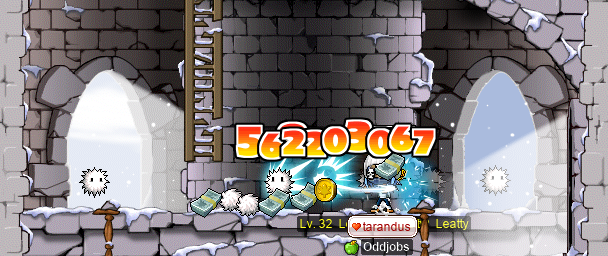
Once I had killed enough Leatties to satisfy Alcaster, I took the Snow Rose Seed back with me to Magatia, and collected the rest of the ETCs for Humanoid A. That meant collecting Gelatins from the Cube Slimes in Unit 101 of the Zenumist Research Institute…:

…Plus some Pieces of Mithril from the Mithril Mutaes in Area B-1 of the Alcadno Research Institute Lab:

And now, I was ready to harvest a Snow Rose from this special-sauce horticultural… laboratory… thingy:
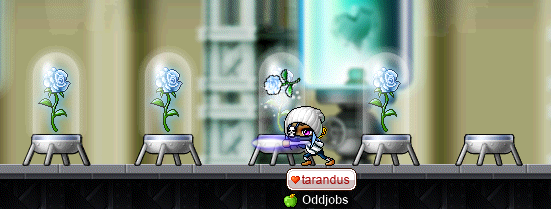
I’ve no idea what this is… maybe some kind of aeroponics lab? Anyways, this quest is ultra weird because the whole point is to get this Snow Rose for Humanoid A so that they can give it to Philia… who is… still trying to figure out what happened to her husband… ouf……
This… is my favorite flower. I just don’t know why he’d give me this… Humanoid A… He’s a great person, I mean, a great Humanoid, but I already have a husband…
Anyways, I’m level ≥70 now, so I can continue on with the main Magatia questline! Hooray!! I started Zenumist and the Missing Alchemist, where I was sent to the Closed Lab to hunt Homun of Closed Laboratory for a Magic Device:

Using some spoopy magic alchemy, I extinguished the Magic Device’s source of luminance to obtain a Lightless Magic Device:
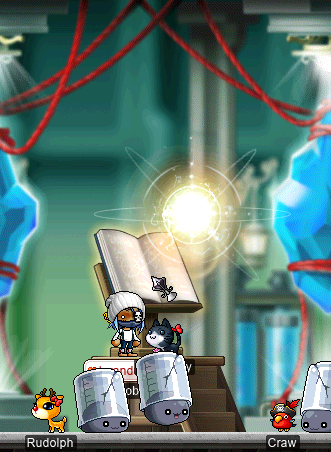
On the other side of town, I did Alcadno and the Missing Alchemist, which had me killing a gaggle of Homunculi over at Unit 203 of the Zenumist Research Institute:
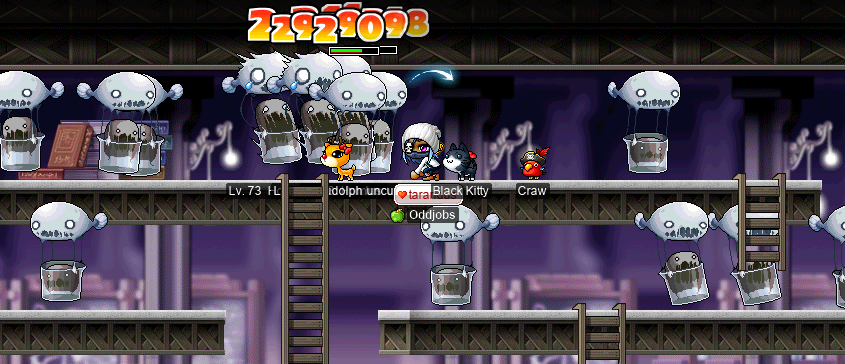
Also for this quest, I had to go see our guy Eurek the Alchemist. So I decided to make use of the ✨new✨ Perion → Magatia portal to make this faster for myself; I could simply take Karcasa’s taxi from Ariant to Victoria Island, and then use the aforementioned portal to come back!
If you’ve not already seen it yourself, this is what the portal looks like — it’s in Iron Boar Land:
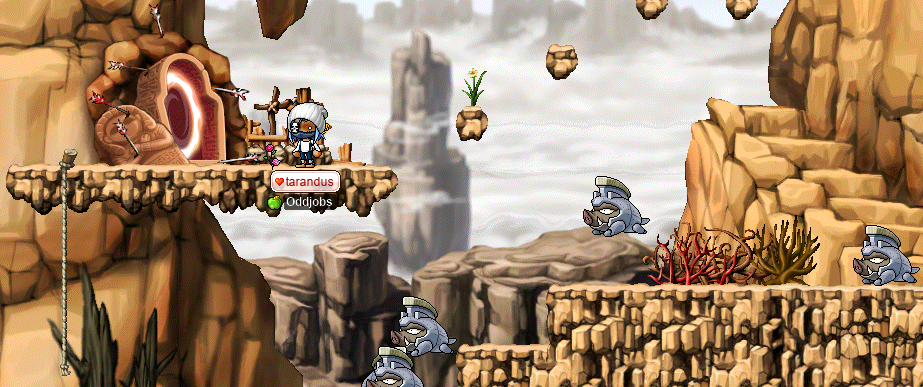
Also note that using the portal consumes one Desert Coin, which is an untradeable ETC item that can be purchased from Manji for 5 000 mesos each. This makes it very similar to the Nautilus (Navigation Room) ↔ Omega Sector (Command Center) portal, except that it’s one-way (you cannot use it to go Magatia → Perion).
At the Alcadno Research Institute, I went to see Parwen to do The Secret, Quiet Passage:
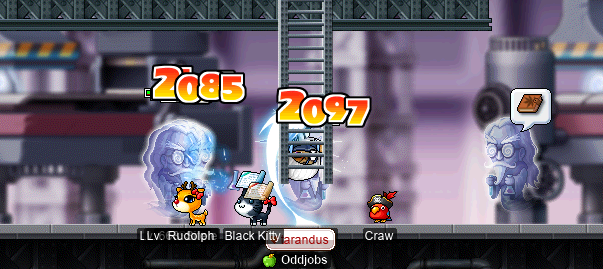
Parwen’s Entry Pass acquired!
In order to unlock both sides of the Secret Basement Path that connects the Zenumist & Alcadno sides of the town, I would need the special passcode. The passcode appears to be the same every time, as far as I can tell. It consists of ten (10) ASCII characters, and only seems to use digits and uppercase letters. As it happens, “only ASCII digits & uppercase letters” is the usual script for writing Base32[1]. In base 32, each digit represents 5 bits (32 = 25), which means that Parwen’s passcode — assuming that it really is a number in base 32 — carries 10 ⋅ 5 = 50 bits of information, which is 50 ÷ 8 = 6.25 bytes. The usual standard for Base32, RFC 4648, makes padding[2] optional, so the fact that the passcode lacks padding would not be unusual (again, assuming it really is Base32). If it did have padding, it would need 6(!) trailing equals signs (======) to bring the total number of characters from 10 to 16. Oof. I did notice that the passcode has an 8 in it, though, so it’s definitely not RFC 4648 Base32, as that format omits 8 to avoid confusion with B… Oh, and in case you were wondering, the largest number representable with 10 digits in base 32 is 3210 − 1 = 1 125 899 906 842 623 = 3 ⋅ 11 ⋅ 31 ⋅ 251 ⋅ 601 ⋅ 1 801 ⋅ 4 051 ≈ 1.1×1015.
In any case, I found Dr. De Lang:
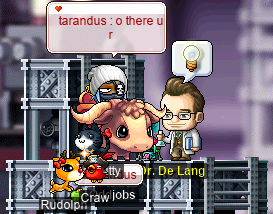
That was easy…
Oh, wait, no, Dran’s Lab is just a figment of Parwen’s feeble memory. Darn.
Unfortunately, I’ll need to be level ≥75 to finish up the Magatia questline for good, so it’s time to do some quests elsewhere… Unfortunately, at this point, I am really running dry on quests. The quests that I have remaining all satisfy one or more of the following:
- The quest is just weirdly low-level for how difficult it is, so there’s no way my level 72 ass is doing that shit.
- The quest asks only (or almost only) for ETC items that I can acquire without too much trouble, but it’s either a massive pain in the ass to do without buying them or using items that I’ve already farmed (e.g. farming 30 Lucky Charms), or I will have to use another one of my characters to farm them.
- The quest requires PQing.
Naturally, none of these are ultimately dealbreakers; I will still eventually complete all of these quests. The only slight exception is PQ quests that require PQ grinding. I’ve already talked about tarandus’s… “adventuring route”, if you will, in previous diary entries. The basic idea is, of course, that she does quests — and only quests, to the exclusion of grinding, PQs, bossing, card-hunting, etc. — for EXP. In pt. xc of this diary, I talk about doing the Papa Pixie quest on tara, justifying it because I only needed to do one (1) OPQ to complete it. With something like, say, Yulete’s Reward, I would need to do — as far as I can tell — a theoretical minimum of six (6) MPQs (one to unlock Yulete’s Lab, and five more to get the marbles required to craft the cheapest item: a Rock of Wisdom). To give an even more dire example, consider Eliminating the Pirates. That quest sucks. And I mean, like, I actually despise it. There’s no telling how many god forsaken PPQ runs it might take to get that many Devoted kills, and what really makes it so awful is that you have to convince your party to let you do the quest… every… single… PQ… twice per PQ. And I need plenty of help with it, too, unless I want it to actually take 100 PPQs to complete… 🙄 So, yeah. I’m not so sure about that shit.
Anywho, I did one or two of Lita Lawless’s Silver Deputy Star quests, which got me to level 73~!:
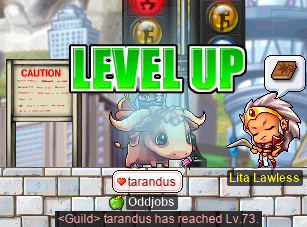
I also did the Rāvaṇa prequests. Being level 73, tara just can’t really do these on her own, so I just transferred the ETC items to her. With that, it was time to get tara a Rāvaṇa Doll for The Final Stage of the Sealing Ritual. You can see me here (as my STR bishop cervid) battling Rav alongside shadower Harlez (Murhata, VigiI), whilst tara waits patiently to loot a doll:

And with that, one fake Ravana Helmet for tara, comin’ right up:
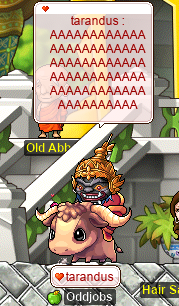
Bone-chilling.
I also made sure to do the Sunburst repeatable quest at least once:

Now that I’m 13 levels higher than when I started the damn questline, it’s time to finally make some actual progress on the Papulatus prequests. The Protect Ludibrium asks for 300 Tachions, which I already collected long ago; however, it also asks for 100 Mysterious Powders, which is not so easily done. For these, I would need to head to Lost Time to fight MDTs:

As you can see, MDTs are level 89, which is… still 16 entire levels above me. Nevertheless, that’s at least better than being 29 levels above me, so I was still able to kill them with some concerted effort and a Sniper Pill or two. I was also aided by Harlez, who came to Lost Time to help farm the powders:

With 100 of them collected, it was time to do Flo’s quest: A Piece of Crack. For this, I would need to hunt for the three pieces of crack from GSVs and/or GPWs, which are 25 and 26 levels above me, respectively. Oooouf…

Yeah uhhh… no. Thankfully, these pieces of crack actually seem to have a pretty generous droprate, so Harlez was able to generate them in just a minute or two. :P Unfortunately for me, however, the next quest in the line (which is simply entitled “Papulatus”) is level ≥80 only. :c So, no Ludibrium Medal for me quite yet.
That brings me back to Masteria, where I continued the CWK questline by heading to Lukan at the Phantom Road and starting The Brewing Storm. This quest just asks for ten (10) Stormbreaker Badges. Unfortunately, badges don’t drop very readily, and the seemingly “good” maps for Stormbreakers are all inside of CWKPQ. So I went to the Cavern of Pain, where it was time to experience pain… & suffering…:
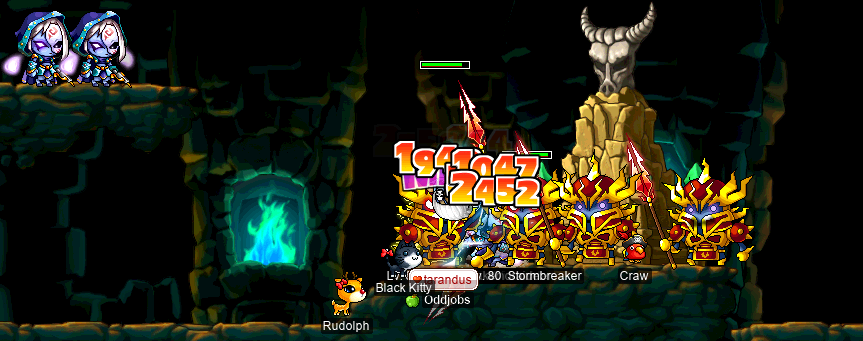
Eventually, though, the badges started popping up:
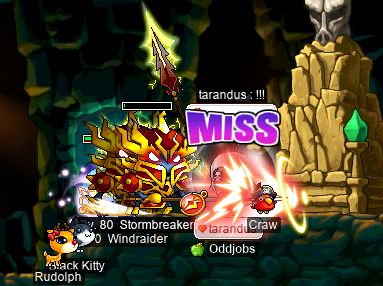
Harlez was also there helping me farm badges, but we found out that half of the map is regrettably inaccessible to anyone without Flash Jump, Assaulter, or Recoil Shot (or maybe a high-level mount…?):
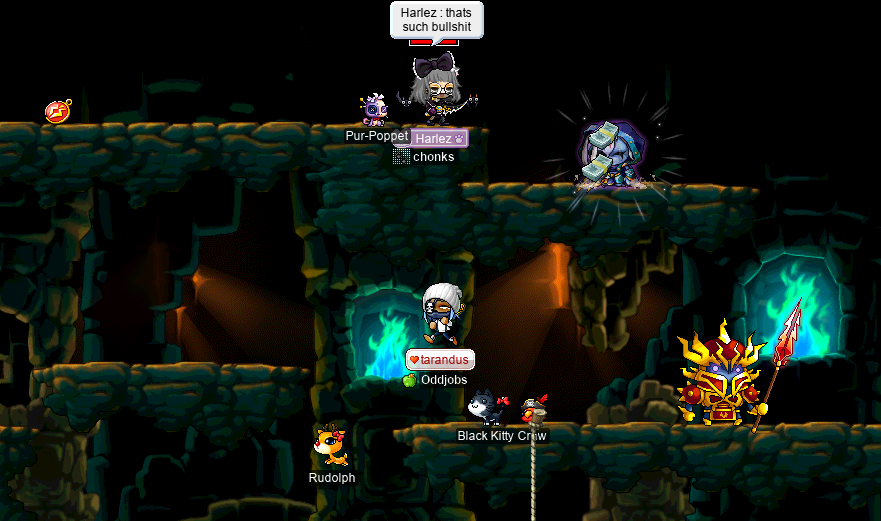
Because Assaulter works, you might expect CSB to work as well. Unfortunately, it does not; Assaulter was made for mobility, whereas CSB is more of a bullying attack, so its vertical reach is little to none (although it can be used like Assaulter to a limited degree). In the end, I did get the ten badges, six or so of which I farmed myself. Now it was time for the next of Lukan’s quests: Storming the Castle. This one requires 75 kills each of Windraiders, Firebrands, and Nightshadows. The Windraiders wouldn’t be a problem to do myself, but for the others, it seemed like the Path of Strength was the best choice:
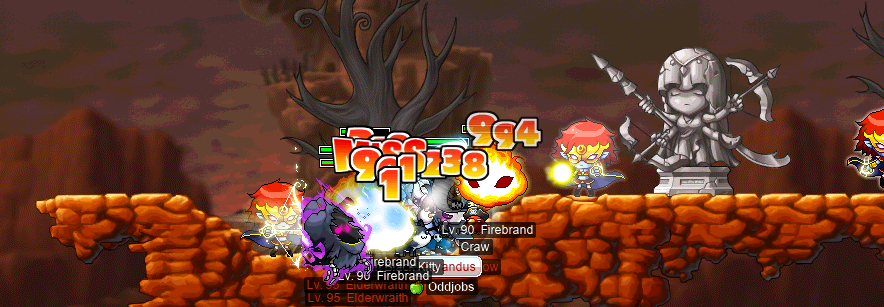
Le sigh. These guys are just too strong for me at this level, and because they’re so much higher level than I am, I can’t share kills with my party members. So this one will just have to wait until I’m level ≥100 or so…
And now, I have been left with no choice. I’m still level 73, and the only doable quests that I have available are… PQ quests!! Frick!!!
Alright, I guess it’s time to MPQ it up…

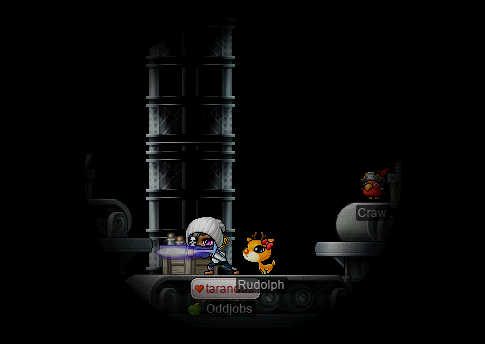
Here’s a fun little visual bug from stage 6:
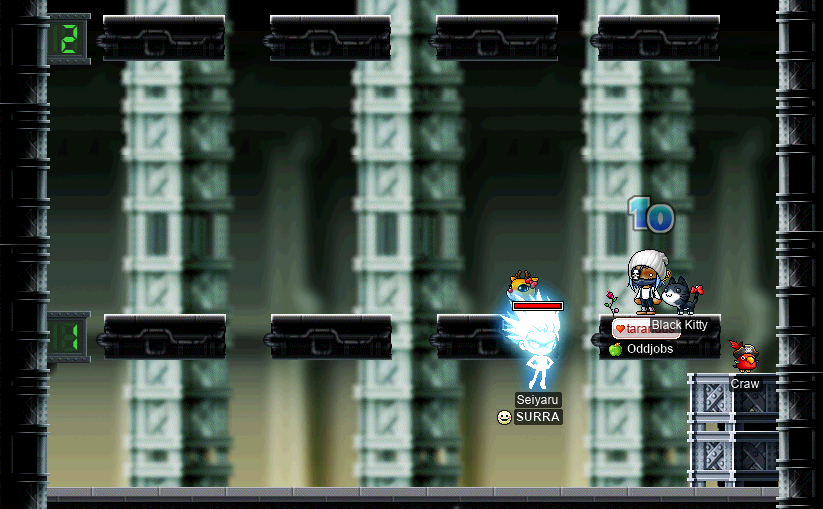
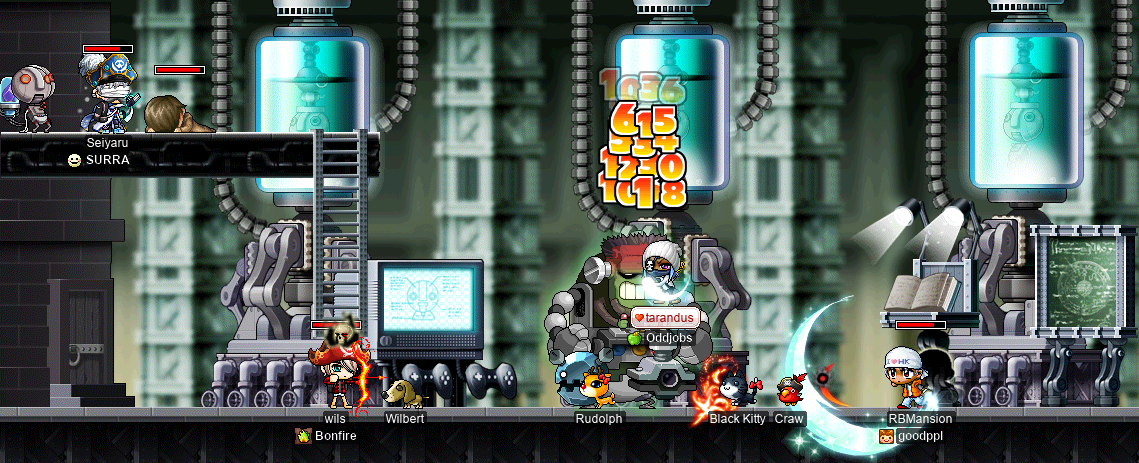
So, there are basically three quest(line)s that are tied in with MPQ: Keeny’s Research on Frankenroid, Yulete’s Request/Reward, and Zenumist/Alcadno and the Ostracized Research. This last one is bugged in MapleLegends: although either one (Zenumist or Alcadno) is supposed to be completable — with the player choosing freely between them — the Zenumist one can be started, but cannot be completed. I actually did a few MPQs before I found this out, realising that we had been killing incredibly slow-spawning diaper robots in vain… Once I found this out, though, I was able to swap it for the Alcadno version and complete it successfully.
As for Yulete’s quests, I did Making the Reagent…:
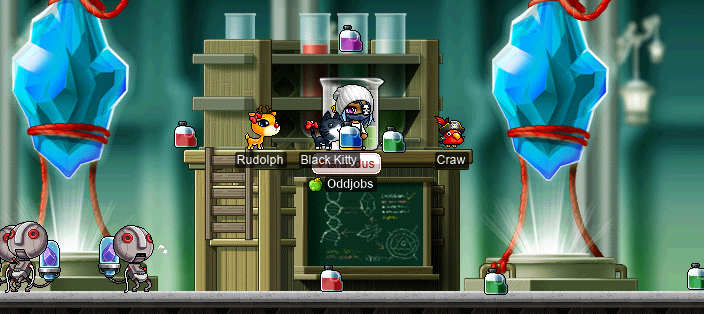
…Organising the Lab Report (my least fav)…:
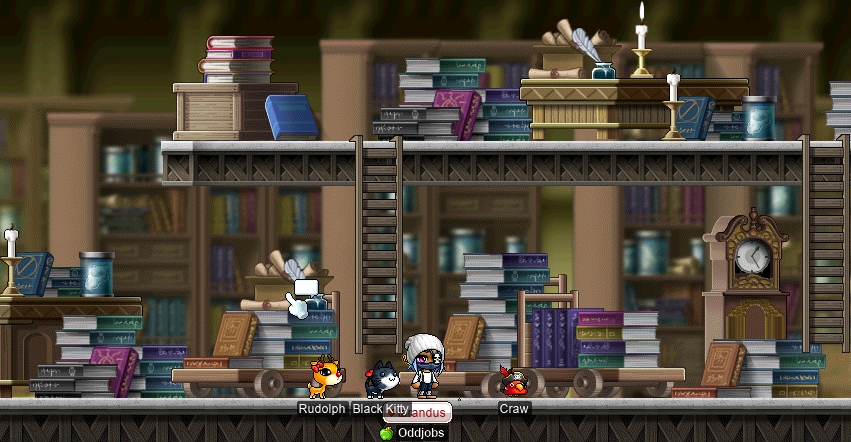

Of course, to really finish with Yulete’s quests, I would have to craft something(s) using the marbles obtainable from MPQ completions. But we’ll get to that later…
With a few MPQs under my belt, I was now level ≥75, so I could finally wrap up the Magatia questline for good. For Dr. De Lang’s Notes, I had to sneak down into Dr. De Lang’s abandoned basement by using the passphrase that Phyllia[3] gave me:
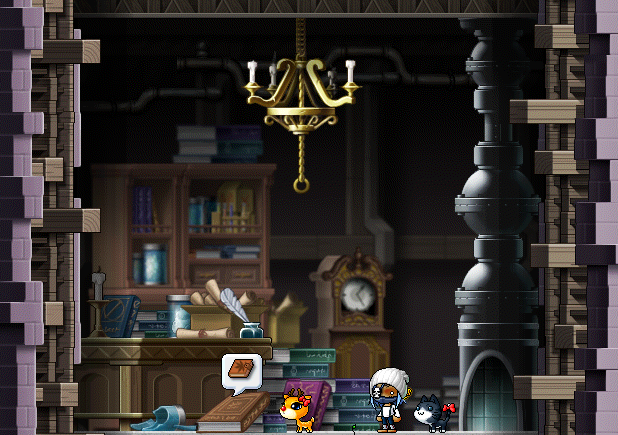
It was there that I found Dran’s Note[4]. I took this notebook to Alcaster, because he seems like an old beardy wizard who probably knows how to reveal the steganographically-concealed notes written within. Alcaster offered to do some magic shit for that purpose, but warned me that it was super expensive and takes forever. However, there is another way…
By slaying a Homunscullo…
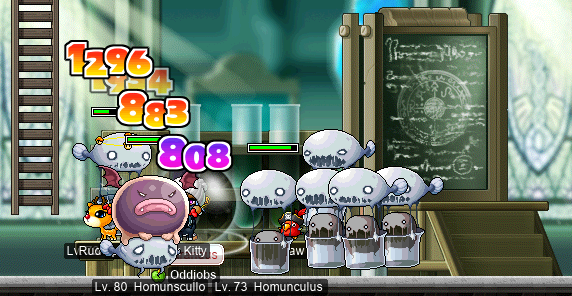

…I could give the blood to Alcaster, and he would do some different magic shit to reveal the contents of the notebook. Well, actually, he kinda just poured the blood all over the notebook. But it worked! It’s a li’l sticky, though!! Ew.
Anyways, it was time to activate The Black Magician’s Magic Pentagram, because that sounds super safe and definitely won’t unleash any horrible supernatural plague upon the land or anything like that. Of course, to get to the pentagram, I would need to complete a treacherous JQ in the dark…:
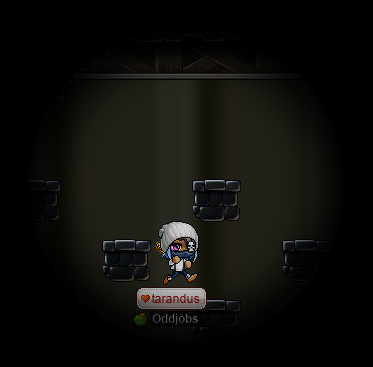
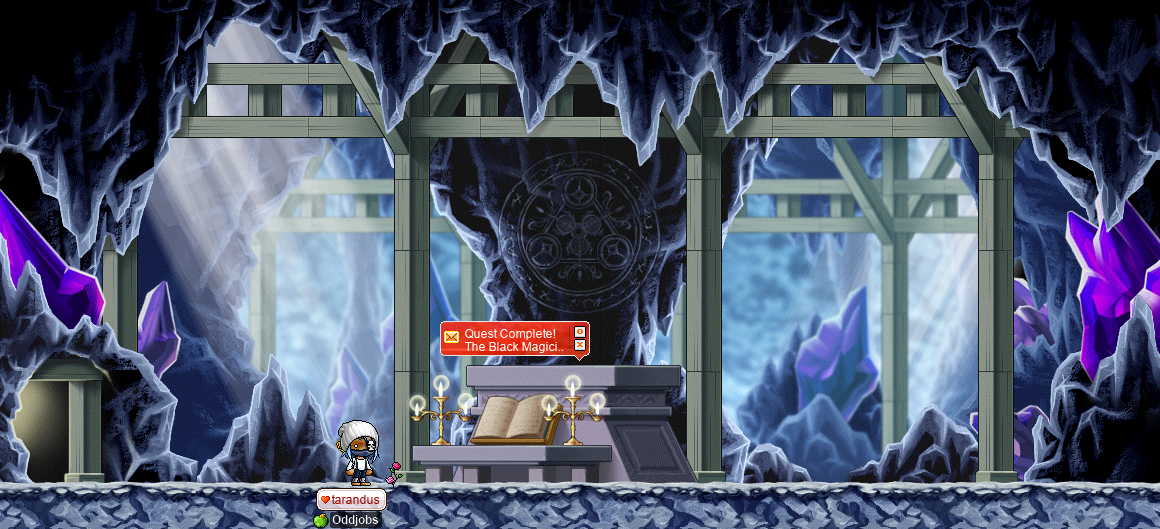
Aaaaand… nothing happened! Great. That’s a lot better than the supernatural plague thing. Now that I had completed De Lang’s life’s work or whatever, I gave his notes to his wife, thus concluding the Magatia questline~
I also did some PPQing in an attempt to do the associated quests:
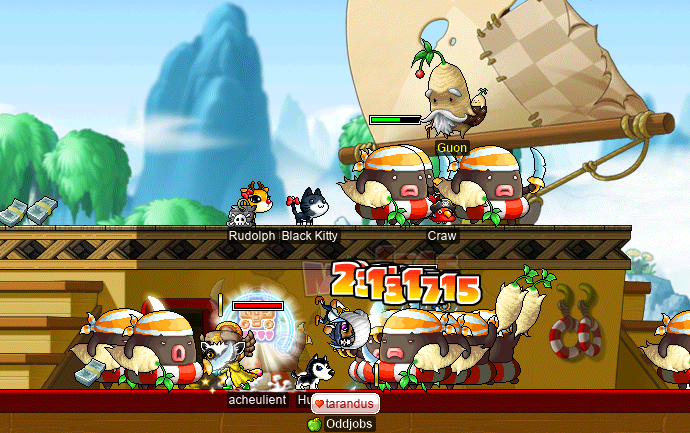

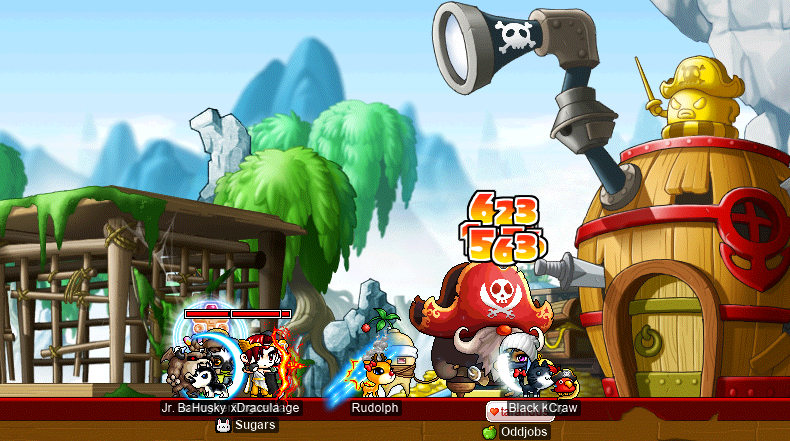
Including getting a handful of kills in the dreaded Lord Pirate’s Servant…:

Unfortunately, I still have yet to get the lion’s share of the Devoted kills, and I actually still need an Enraged Lord Pirate kill as well. I plan on getting the Enraged Lord Pirate kill, but the Devoted quest might have to stay uncompleted. 🙄
I went to Leafre to do a level 75 quest by the name of Kumo’s Request, which had me collecting the horns of Beetles & Dual Beetles:

Aaaand it was time to head back to Magatia for some more R&JPQ… 🥲
I did a few MPQs with a fellow marauder by the name of Seiyaru who was… very scholarly. By which, I mean that he had a lot of INT. Like, all the INT. So he decided that, because he couldn’t help us fight, he could at least help by supplying us with various potions & foodstuffs:

Unfortunately, each “pack” didn’t have very many items in it. But anyways, Seiyaru was delighted to hear me say that it’s possible to grind to level 101 via PPQ, although I tried to make a point that it has been done before, but it’s no mean feat…! And I think that maybe Seiyaru — who had yet to ever actually do a PPQ himself — was, perhaps, too optimistic at this point. It was only two or three days later that I saw him smegaing to buy leech… And god bless ’im; it’s just better that way. “PQ leech” isn’t really a thing, & there’s a reason for that…
Someone with whom I had PPQed told me that I should slip a single sneaky skillpoint into Energy Drain before continuing to max Energy Charge. I hadn’t thought to do this, as Energy Drain is not exactly my top priority, but I looked at the skill description and realised that they were right: it deals 265% damage at level 1, compared to 270% for Flash Fist at maximum level. That’s “worse” than FF, but only barely, and it comes with the neat healing thing where you heal back a portion of the damage that you deal with it. So I gave it a try:
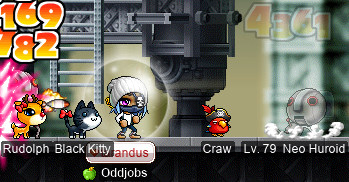
This thing is basically a damn ranged attack! It’s pretty cool to use, and definitely a lot more convenient than FF, which has a horizontal reach of roughly jack squat (and even less vertical reach). Because it’s not actually a ranged attack, and is really just what you’d expect — a melee attack with large horizontal reach — it can be a little wonky to use when there are multiple candidate targets. If one candidate is clearly closer to you than the other, you might naïvely expect to hit the closer one. However, if the further one has “higher priority” (read: its mob ID is smaller, likely because it was spawned first), then the Energy Drain will appear to “go through” the closer one and hit the further one. However, it only seems weird until you realise that that’s just how melee attacks always work, and Energy Drain just makes it more visually obvious. Probably the funniest thing about Energy Drain, though, is that it has a very subtle animation; when you use it, it looks like your character is just… standing there, squared up & ready to throw a punch, but without ever actually doing it. And then the target just… takes damage. It’s like a bizarre staring contest, or something.
I had the pleasure of doing some MPQs with I/L mages iffi (Flurri, SecretIy) and PurplePants; here, you can see us trioing (I used my MPQ mule potpan to allow us to do the PQ as a party of three):
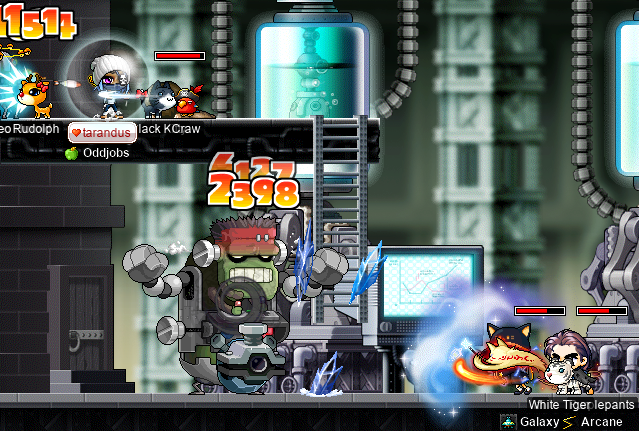
I actually didn’t realise at first that I already knew iffi from doing bosses with her bowmaster Flurri on my darksterity knight rusa. It wasn’t until iffi noticed that I was in Oddjobs, and she said that I reminded her of a friend…
So, as you might have already guessed by now, I reacted to my general lack of remaining quests by deciding that it was time to just get myself a damn Horus’ Eye. In the absolute best case — if I was particularly lucky — I could make out with a fully-scrolled Horus’ Eye having completed just 20 MPQs: 10 of each colour to make the pendant itself. Then, I would just use 3 of the ≥3 Rocks of Wisdom that I had luckily randomly acquired from MPQ completion rewards, and I’d be all done! On the other hand, in the worst case, I could get absolutely no Rocks of Wisdom from any of my MPQ completion rewards. Then, I would need not 20, but 35 completions, because you need 5 of a given marble colour to craft a single Rock of Wisdom: 20 + 5 ⋅ 3 = 35.
This is usually how I explain the whole MPQ marble thing to those who are new to MPQ, but as it turns out, it’s a slight simplification. tara was unfortunate enough to get absolutely no Rocks of Wisdom other than the ones that she crafted, so you’d expect that this is the “worst case” scenario of 35 MPQ completions. However, the parties that I was running with were really picky about which side (Zenumist/Romeo vs. Alcadno/Juliet) that we were to run the PQ on, so I never got to actually run on the side that I needed. As a result, I had already acquired the pendant plus 2 Rocks of Wisdom, and yet ended up with the worst possible array of marbles: 4 of each colour — just barely not enough to use either colour to craft my last Rock of Wisdom. I ended up in this position after a lot of frustrating PQing and just generally having to give in to my party members’ whims…[6] But, eventually, that did mean finally getting that last marble, after 39 (= 35 + 4) MPQ completions:

And, just to add insult to injury, MPQ decided to give me a very special prize for my 39th MPQ…:
![]()
Seriously???? 😤😤😤
Le sigh. At least, after all of that hard work, I have a nice pendant to show for it:
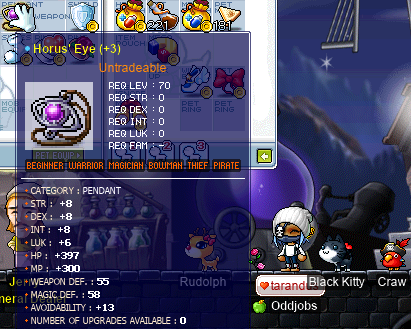
:]
The future of tara
tarandus is level 82 now, and has a few more quests unlocked. I’ll be continuing my questing journey, as you’d expect. But, as we’ve already seen, level 73 just so happened to be the level where I had to start compromising. That in no way means that tara’s journey is over, nor even that the challenge is over. I knew that I would get to this point someday, and the question was basically just “at what level?”. Nevertheless, I will continue questing when possible, and if anyone else had the question of “how high of a level in MapleLegends can you get by exclusively questing?”, then I have an answer: level ≈73 or so.
Note that I said “an” answer, not “the” answer. The particular challenge that I set out for tara had a very particular set of rules & parameters, and I played it out in a particular way. For example…:
-
I didn’t place any particular restrictions on where I got items/mesos from, meaning that it was possible to e.g. buy a quest item from the FM, or transfer it from another one of my characters, or get it from a friend. This made some impossible quests possible, but also meant that I “lost” some EXP where I could have grinded (in some cases, grinded almost limitlessly, e.g. for a Newspaper Hat). On the other side of the same coin, I frequently farmed when I didn’t strictly need to; actually doing the quest itself on tara gives her something to do, and also feels more authentic.
-
I didn’t allow repeating repeatable quests ad lib. There are, of course, some repeatable quests out there, which can in principle just be repeated as a kind of “quest grinding”, if you will. Remember roguelikes? From the “Authenticity in role-playing” section above? Well, I found out that in roguelikes, there’s a different word for “grinding”: scumming. Perhaps this term is more appropriate here, thanks to its pejorative connotation… Relatedly, I don’t consider exchange “quests” to be quests for the purpose of my challenge.
-
As previously discussed, I allowed myself to do exactly one (1) OPQ in order to finish the Papa Pixie questline. When doing a challenge like this, one may very reasonably be tempted to ban PQs entirely. My reasoning for the restrictions that I chose for myself is basically that such a ban is strangely asymmetrical: you ban PQs entirely, but grinding & bossing are both okay, as long as they’re being directly used to complete a quest.
Nevertheless, PQs can have a characteristically high concentration of EXP when compared to farming for quests, which usually involves killing random nonsense, and usually(!) not very much of it. Plus, being a PQ junkie is my usual “route”, so I wanted to make sure that I was trying something different this time, similar to me playing vicloc, or like a more intense version of the PQ–questing hybrid that I did with my daggermit alces for a while. For these reasons, I tried to be conservative with how many PQs I would do for questing purposes, but I was careful not to make any hard restrictions.
-
I also just didn’t do some quests, for various reasons. The Ellinia JQ quests can suck my entire ass, and so can The Record of Goddess Minerva.
-
⋮
Quests only give so much (or rather, so little) EXP, and as tara ventures deeper into the 3rd-job levels, the gaps & crannies in “questable EXP gain” will surely widen. It remains to be seen exactly how I will fill those gaps, but I do know that I want to fill them. Maybe I’ll consider card-hunting for EXP, although there’s no guarantee that I won’t get bored & give up… It is, however, my hope that ordinary grinding for EXP can actually be pretty efficient for tara, with a combination of Energy Blast, Backspin Blow, Stun Mastery, and buffing myself with SE (& MW20 & HS & …). SE and Stun Mastery interact very favourably, and so I’m basically hoping that tara will mature into a Hime-shredding machine. Hopefully.
Hopefully, because I think that tarandus is The Chosen One™. What does that mean, you ask? Well, consider the fact that tarandus is like… my 9th brawler. Maybe 10th — I don’t even know anymore. Not all of my brawlers have been made on MapleLegends; some of them are very old indeed. Maybe you get the idea: I like brawlers a lot, and I keep making them, and then they all get abandoned, one by one. Why do I do this to myself? Not even I know the answer to this question. And not all of them have been odd-jobbed, either, mind you.
Asking the question “why do I do this to myself?” is perhaps unfair to begin with, though; after all, I clearly enjoy playing them for whatever reasons, so it’s not a form of self-punishment. Nevertheless, as I’ve played more MapleStory, and played it more intensely — as I have on MapleLegends — my appreciation for pirates, and brawlers/marauders/buccaneers in particular, has deepened. There are many reasons why I choose, as I occasionally do, to make a new character of a particular job — or even just to play an already-existing character, of whatever job it may be. One kind of reason that I’ve been thinking about a lot is very simple: I see someone else playing a character of that job (or of a similar job), and I am enamoured — “golly gee, I wish that were me”. And this is something that I’ve felt quite a lot when watching buccaneers in my boss runs.
So, I’ve nothing else planned. tarandus is The Chosen One™, and in any case, I reckon I’ve enough MapleStory characters as it is.
Footnotes for “tarandus the pugilist”
-
[↑] Duotrigesimal? Dutrigintimal? Triacontaducimal? Duotriacontal? Triacontakaidecimal? :]
-
[↑] Padding is necessary if you want every string of Base32 to represent an integral number of bytes. For example, the Base32 string
Ais just a single digit representing 5 bits of information, which is 5 ÷ 8 = 0.625 bytes. There’s not necessarily anything wrong with that, but I guess there are reasons why you would add “dummy” characters that have no value associated with them, just to make the number of characters in your string correspond to an integral number of bytes. Of course, just knowing the length of the string is enough to immediately know how many padding characters (=s) need to be added to the end to correctly pad it, which is why it’s not at all obvious why you’d need to explicitly write the padding at all.Here (archived) is a Stack Overflow™ question about almost exactly this topic (except with Base64 instead of Base32, which makes sense given that Base64 is, like, way more commonly used), and frankly, I’m not entirely convinced. The top answer justifies padding by basically saying that concatenating multiple unpadded Base64 strings can result in the byte-level bit positions (e.g. this is the least significant bit of the byte, this is the 2nd-least significant bit of the byte, etc.) of the data in any of the strings — excepting the first one — getting shifted around. Thus, if you have multiple byte strings that you want to concatenate after you have already encoded them into Base64, then padded Base64 gives the correct result, whereas unpadded Base64 does not. However, as a commenter points out:
This answer could make you think that you can decode something like
SQ==QU0=VEpNby just giving it to a decoder. Actually, it seems you can’t. For example, the implementations in JavaScript and PHP don’t support this. Starting with a concatenated string, you either have to decode 4 bytes at a time, or split the string after padding characters. It seems like those implementations just ignore the padding chars, even when they are in the middle of a string.This doesn’t totally defeat the purpose, as you could just use an implementation (or write one yourself) that does correctly handle mid-string padding, but it does limit the practical utility.
As far as I can tell, it’s really more about making decoding implementations simpler: if you know that the input is valid, properly-padded Base64, then you can correctly decode by looking at exactly-4-character chunks at a time, and nothing else. That’s nice. In particular, the idea is probably to get performance improvements — especially if using SIMD instructions.
-
[↑] Is it Phyllia, or Philia? MapleLegends disagrees with itself, and also disagrees with BBB Hidden Street. Personally, I prefer Phyllia, but the actual NPC in-game in MapleLegends is indeed Philia…
-
[↑] This would seem to be another inconsistent naming, but the better explanation is that Dr. De Lang’s full name is *Dr. Dran De Lang, PhD or similar.
-
[↑] Another inconsistent nomenclature… Homunsculer Sand (the ordinary ETC item dropped by Homunscullos) and the Homunsculer’s Blood call it Homunsculer(??) instead of Homunscullo. Rhoticity is hard, I guess…?
-
[↑] In case you’re not already familiar, there is no actual difference between the two sides, other than the colour of the marble that you obtain from a successful completion. If this sounds mildly insane to you, considering that the marble colour is actually relevant (e.g. you can craft a Rock of Wisdom with 5 pink marbles, but not with 3 pink ones & 2 blue ones), then you might just understand how MPQ currently works. If you asked me, I’d tell you that they should be merged into a single colour…
Anew
If you’re a long-time reader of this diary, then you know that I’ve done many things in MapleLegends with xBowtjuhNL and Harlez (VigiI), ever since I met them on my darksterity knight rusa at MPQ. Well, both of them have new characters in the works!! Actually, xBowtjuhNL’s baby cleric PriestjuhNL is not that new, strictly speaking. But he’s been level ≤30 for a very long time now, and now is the time to take the world on by storm — to live up to the PriestjuhNL name! By actually becoming a priest!!
I did some good ol’ LPQing with PriestjuhNL, on my DEX brawler LPQ/EPQ mule sorts:
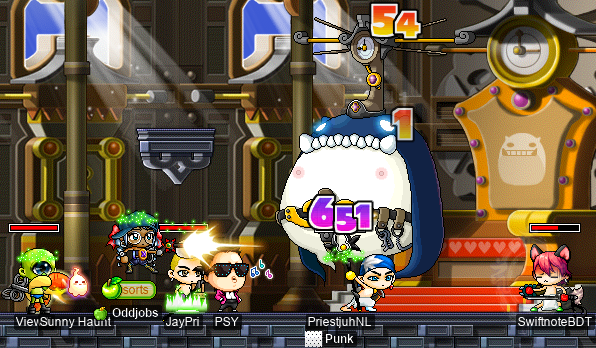
We also did some EPQ, as well, where I got to show off my CSB…:

…And we fought BBRG[1]:
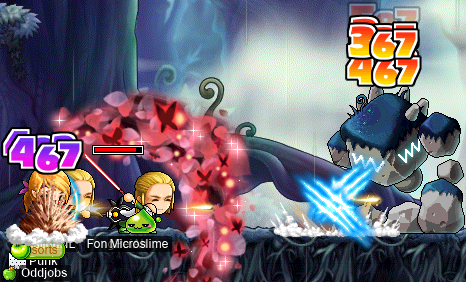
Likewise, Harlez made a ✨brand new brawler✨ by the name of Murhata, so I escorted her through Maple Island on my islander ozotoceros. It wasn’t long before I had to say “bye” for good… they really do grow up so fast 🥹:
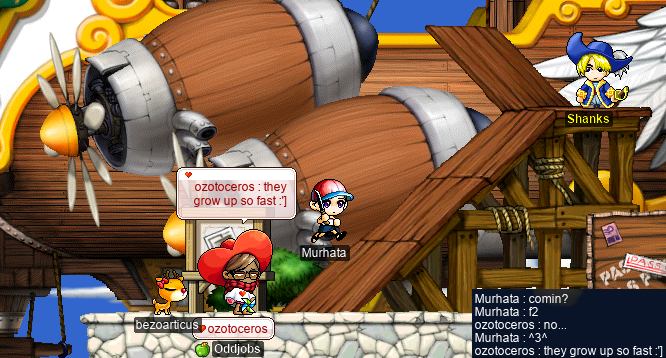
Nevertheless, I was able to do a handful of KPQs with Murhata on my DEX page KPQ/SGQ[2] mule kinds:
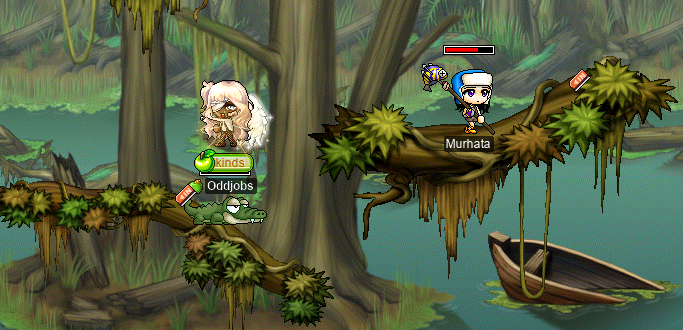

But now, Murhata is on to punching bigger & better things, questing in the wide open Maple World~
Footnotes for “Anew”
-
[↑] Big bad rock guy.
-
[↑] Look. I know it’s weird, but hear me out. The Sharenian expedition is just that: an expedition. Well, sort of. It doesn’t have the notion of “signing” per se, but the way that you enter the Excavation Site map that has the big blue swirly portal effectively is “signing”: the “expedition” leader “starts signs”, and then anyone who wants to participate goes into that map in lieu of “signing”. At this point, the quest is not actually started at all, until the timer finally counts down, and you can use the portal to enter the first stage; thus, the big blue swirly portal effectively takes on (part of) the role that the Mark of the Squad has in the context of Horntail. The slight difference is that the portal activates after a fixed amount of time following the starting of “signs”, whereas in Horntail, the expedition leader must manually start it. This difference makes at least some sense, considering that SGQ can be started as many times as you like, whereas HT’s first prehead can only be summoned a maximum of twice per day (on a per-PC basis).
Other than these technical details differentiating SGQ’s signing-like mechanics from other more conventional expeditions, all of the actually important hallmarks of an expedition are present: there is an expedition leader, forming a party or parties is completely optional and unrelated to the expedition itself, and up to a maximum of 30 PCs are allowed to take part in the expedition. Thus, SGQ is not a party quest, and terms like GPQ (guild party quest) and SPQ (Sharenian party quest) are misleading at best.
The source of most of SGQ’s uniqueness, however, is its guild-based nature: all participants must be members of the same guild, and furthermore, one major reward — viz. Guild Points (“GP”) — for completing the quest is given to the guild, not to any of the PCs. Furthermore, SGQ is kinda the only — or one of the only — non-boss expedition(s) in the game. An argument could be made that Core Blaze also qualifies as a non-boss expedition, but the argument is basically a highly technical one that isn’t very interesting, and used to not be true in MapleLegends — see the footnotes of “未来トウキョウ第二部” in pt. xc of this diary for more details. More convincingly, CWKPQ could also occupy such a position, but that’s more of an indictment of the term CWKPQ than anything else — neither CWKPQ nor GPQ are actually PQs! In any case, if we had to decide which is more “PQish” between CWKPQ and SGQ, I think that the distinction (somewhat ironically) pretty clearly goes to SGQ. See “Seed ubble euch ayyy peak you” in pt. lxxxvi of this diary for more of my thoughts on CWKPQ as a PQ. SGQ, on the other hand, is not so extremely boss-heavy, and each of its many stages feels like its own significant part of the quest.
So, what is it called? GPQ. The problem with calling it GPQ, however, is that it’s wrong on not one, but two counts. First is of course the fact that it’s not a PQ at all, and second is that even if it were a PQ, calling it GPQ is incongruent with most other PQ names: HPQ, KPQ, LPQ, EPQ, OPQ, LMPQ, HTPQ (in the now-dated original sense), & MPQ are all of the form [location] + PQ. Calling it SPQ fixes the latter problem, but not the former. If we go one step further, and call it a guild quest instead of a party quest, then we have fixed both problems: *SGQ. Unfortunately, I had to prepend an asterisk (*) there, because I more or less pulled this little bit of terminology directly out of my ass. Absolutely no one (well, except for me now) calls it *SGQ, but that is in fact what you (can) get if you take the GPQ nomenclature to its logical conclusion.
Also note that *GQ is similarly valid by this logic, but has the downside of relying on there only being one guild quest in the entire game. That’s true for MapleLegends, but not necessarily true in general (including possibly for future MapleLegends… Who knows……? 😉).
Bossy pants
I was invited to a ✨very special✨ (at least, for me :P) pair of Zakum runs on my woodsmaster capreolina. What was so special about it, you ask? Well, they were quartet Zak runs. Yes, that’s right: just my poopy self and three (3) other folx!! I ran with dark knight Papelazo, bishop Bamuku, and nightlord Eugenie:
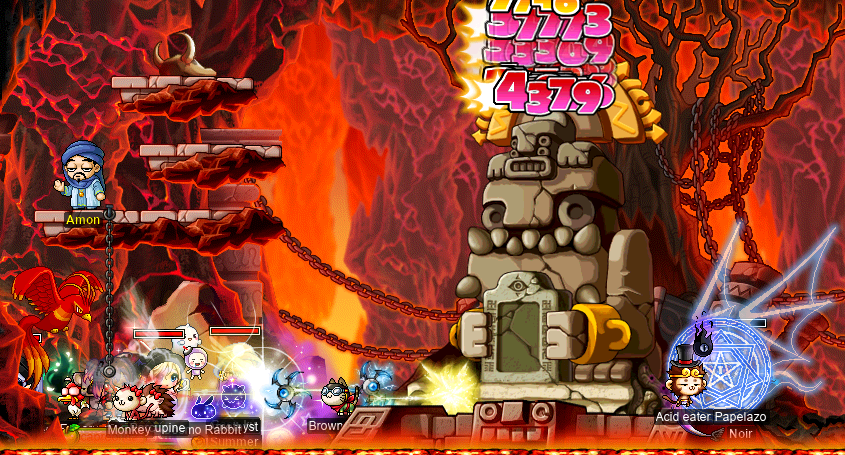
You can also see another PC hiding on the far left there, but that is just a level 134 buccaneer that was being used as an SI mule.
To help make me a little stronger, Harlez (Murhata, VigiI) threw two Energizer Drinks at me before I was to start the runs. Here’s what my damage range was looking like with the Energizer, plus an Echo and MW20:
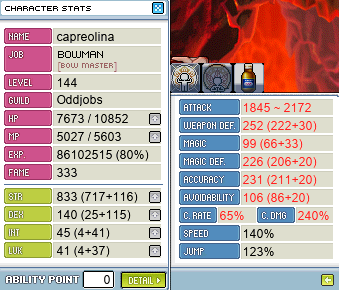
As it turned out, the runs were surprisingly speedy! Each run was only just over half an hour, so the two Energizers worked out very nicely. And oh boy, the EXP sure is nice when there’s only four of ya. I even hit level 145~!:
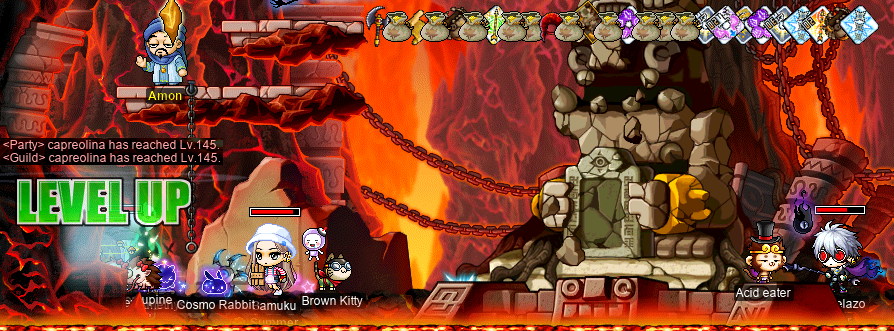
Huge level! I’m technically high enough level to JC now!! Not that that’s a very good idea for capre, but, you know……
I also did a handful of fun Rāvaṇa runs, including this one that I did on my darksterity knight rusa alongside marksman Level1Crook (Lvl1Crook, xXCrookXx, Lanius) and STRginner extraordinaire Taima (Boymoder, Hitodama, Hanyou)…:
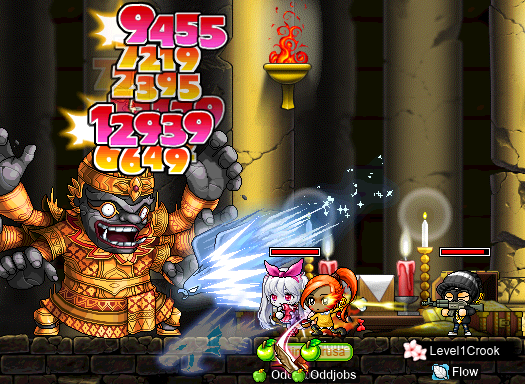
…During which, Taima hit the colossal level 130!!!:
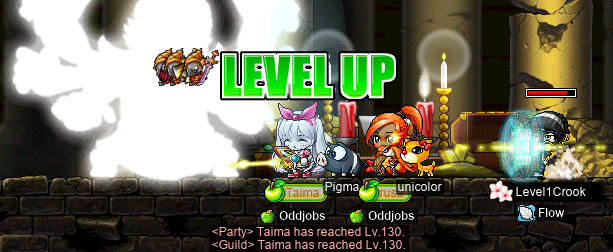
Congrats again to the poggiest pogginner in MapleLegends!!!!
And I also did a few Ravs on my STR bishop cervid, with Harlez:
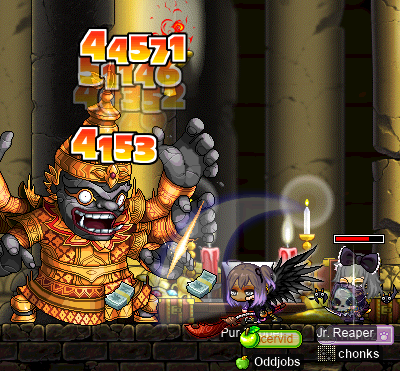
I gave it the ol’ @dpm treatment with just a Cider & MW20:
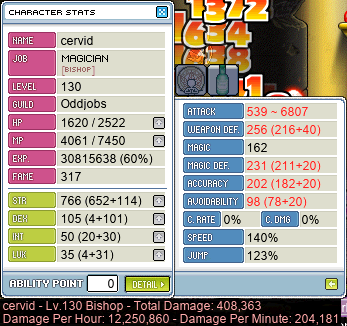
204k DPM! Not too shabby for a bishop swinging a glaive!! But mayhaps I can do better…
roosypants
I also helped out a little bit with killing Bigfoot, duoing one on rusa with Level1Crook to help DEXginner inhale get a toe!:
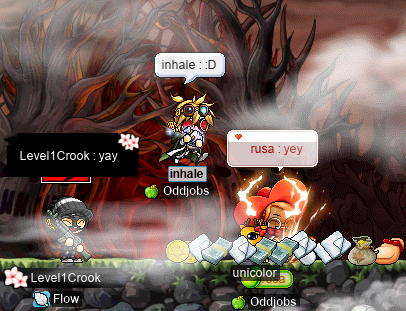
The aggro/monstercontroller situation was really weird as a dark knight trying to duo with a ranged attacker. When soloing, I control Bigfoot’s movement to a much greater degree, and it basically just faces the wall and stands there jumping in place. This is nice, because I can more easily stay at low HP for zerk purposes without dying to a faceful of Bigfoot. I expected to be able to do something similar here, considering that both Level1Crook and myself are perfectly capable of knockbacking BF on every attack, and thus could “just pin”. BF, however, was having just about none of that, and instead decided to mysteriously teleport out of pin several times, one of which actually killed me. 🙄 So, you know, gotta be a little more careful…
Speaking of hubris, I was half-jokingly convinced by Harlez to try attacking on both capreolina and rusa at the same time, with ✨the power of in-game macros✨! The basic idea is simple: choose an attack skill (unfortunately this step doesn’t work if you choose “basic-attack”…), and then make a new macro with all three slots filled by that skill. Then, instead of holding down the skill button, I can just press the macro button occasionally, and my character should still basically be spamming the attack. Right? Then I can kinda just switch back & forth between the two windows, pressing the special-sauce macro button in each. And then I’ll be attacking on two characters at once! Except for, you know, the other important stuff involved in attacking. But who cares about that nonsense? It’s time to just recklessly try it anyways!:
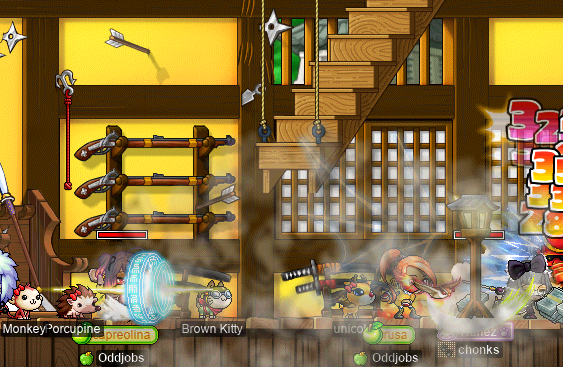
As I mentioned, this trick will not work with basic-attacks. However, there’s other caveats as well; for example, I can’t use this with Hurricane. That’s why you see capreolina using Strafe in the above image. Oh, and in case you were wondering, the boss that we’re fighting is an area boss by the name of Kacchuu Musha, a.k.a. Samu.
Actually pulling this off was… not easy. And it was pretty shaky, too; I would have been able to perform a lot better on either character by just playing that one. There’s a lot more to it than just pressing a macro key every few seconds. Oh, and in this particular case, I was concentrating very hard on attacking on two characters at once, and not so much on a certain detail that I failed to notice for several minutes…:

🤦🏽♀️ Right. I forgot about the part where Samu has 3.2k WDEF, and rusa is using some of capre’s gear… Welp. I think that about concludes that experiment. It wasn’t very fun to play, anyways…
Speaking of Samu, I did a few other area bosses with Harlez, but this time without trying to also semi-AFK Strafe 🙄…

…Including Black Crow:

Plus, I did a little more Horntail!! I’ve never actually tried doing @dpm tests on the preheads, so here is a little @dpm 2 that I did during one prehead with HS:V, Echo, MW20, & SE:
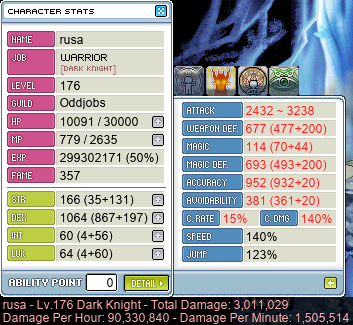
I also did a duo D’una run with Harlez…:

…During which, Harlez got stuck in one of Neo Tokyo’s many bizarre footholds!:
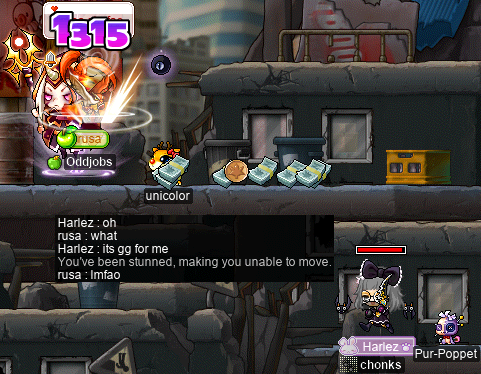
Don’t worry, though; eventually D’una managed to knock Harlez back and out of this foothold trap…
I also did a fun trio Bergamot (yes, the citrus fruit — yummy yum yummers…) run with Harlez & xBowtjuhNL (PriestjuhNL):
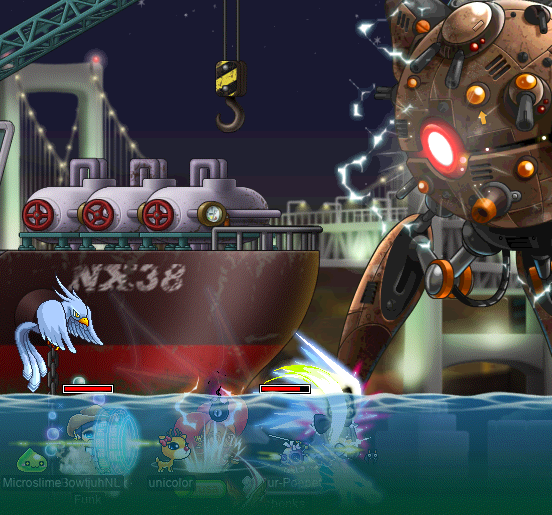
And, eventually, after many a boss run, I was almost level 177!!! So I went to my old friend 7F with Harlez to finish off the level!!!!:
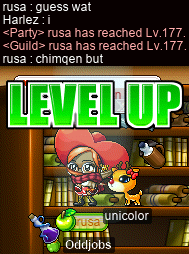
😎😎😎
And, last but not least, here are some fun reactions from people seeing me gigazerk (see “Berserkr” in pt. xc of this diary)…:
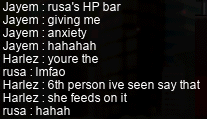

F3
What is an “card”?
I have kind of a problem, which I’m sure I’ve spoken of in this diary before: so many characters, and yet so little motivation to card-hunt. I mean, don’t get me wrong — card-hunting can be fun. But, like, there’s probably at least a few other things that I’d rather be doing. Plus, I get easily annoyed with chance-based stuff like that. If a card set just rAnDOmLy refuses to drop for me, I get a li’l cranky. So I’m trying to have some clear priorities, even though that’s really hard when, again, I have all of these characters that clearly want higher Monster Book Ring tiers.
In any case, I’ve since decided to focus on my darksterity knight rusa, so here goes nothin’…
One card; two cards; three cards, four…
I decided to just start doing the Nihal Desert card sets, which I have yet to start working on. So, starting at the lowest-level sets, we have the Desert Rabbits (F) over in the only map that they spawn in — Outside East Entrance of Ariant:

Desert Rabbits (M) also spawn in this map, albeit at only half the rate:
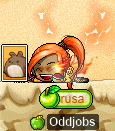
A better map for the (M) ones is Tent of the Entertainers, but as it happened, the (M) cards dropped at well over twice the rate that the (F) ones did, so I ended up completing both sets in Outside East Entrance of Ariant, finishing the (M) set first…
With those done, I went to slay some Cacti…:

…And Jr. Cacti…:

…Outside the West Entrance of Ariant. Once I had finished the Jr. Cactus set, I moved to Cactus Desert 1 to finish up the Cactus set.
Over at the White Rock Desert, I did the Bellamoa set:

And I started hunting at the Dry Desert, for Ear Plug Plead cards and Scarf Plead cards:

And that’s all I got so far! :X Stay tuned……
« Victoria » y triunfo
It is now time for the Victoria Island segment! With my vicloc characters, d33r the clericlet & d34r the dagger spearwoman!!
Here’s a screenshot from one of d34r’s APQs, marking the first time that I’ve ever actually seen the Rombot-looking guys (I don’t actually know what their name nor mob ID is) from stage 5:
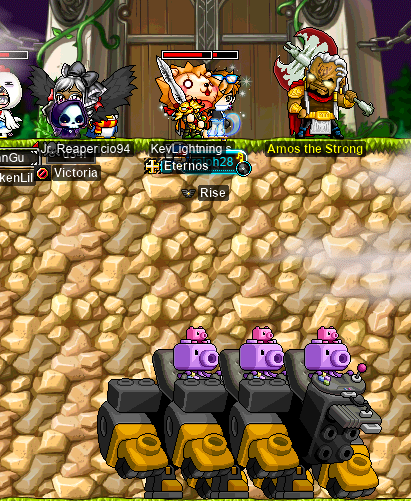
Yes, the fabled APQ golems that kill you in one hit! We were waiting for an AFK party member who never came back…
I also did some FoG grinding on d34r with GM buffs, and hit level 88~!:
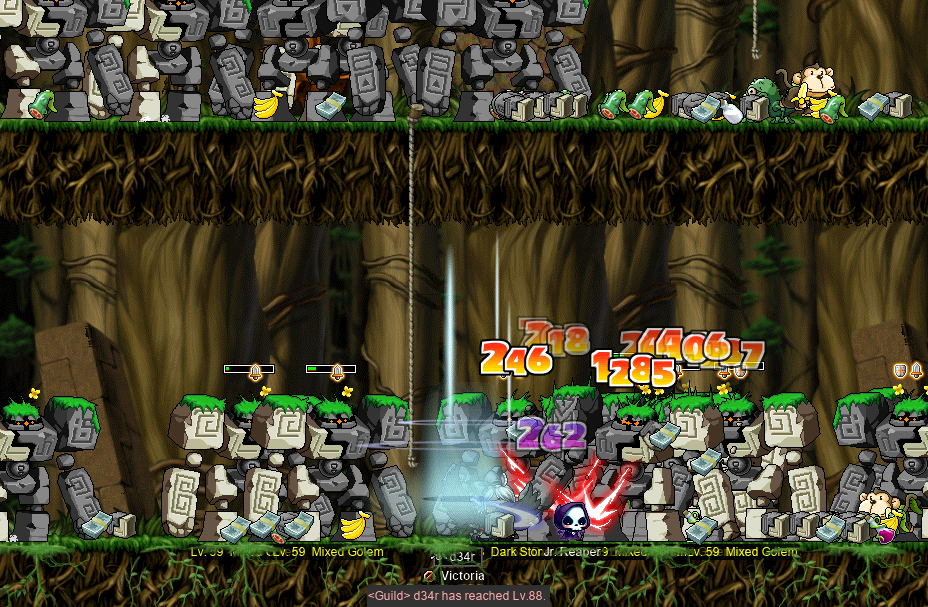
And that’s not all — I used even moar GM boofs on d33r at L1A4, and got to level 69~!:
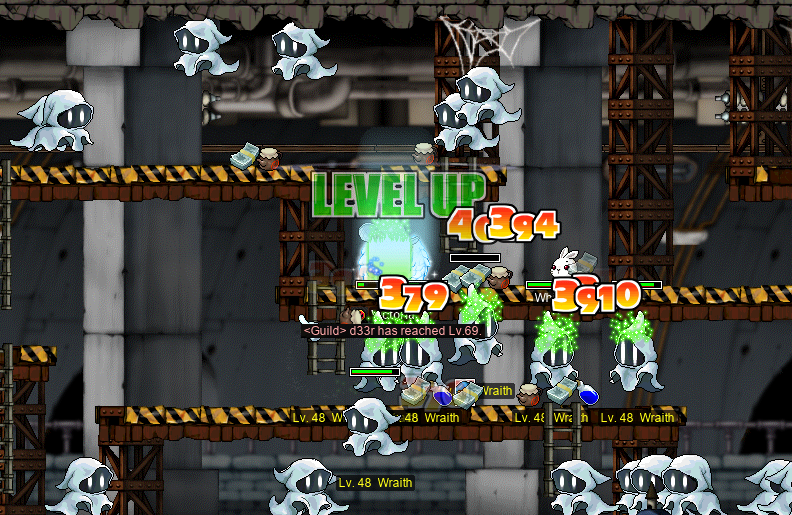
Nice!!!
Oh alces, ¡cómo quisiera que te alces al nivel 120!
In the previous diary entry, I introduced the “alces challenge” that I started for my daggermit alces. The basic idea is very simple: the challenge is to grind EXP on alces for exactly 60 minutes each day. So, to start things off, I did some grinding at CDs with fellow odd hermit Boymoder (Taima) the STRmit, and INTlaw Lvl1Crook (Level1Crook, xXCrookXx, Lanius):

There’s really nothing quite like Taipei 101 when it comes to crushing one’s own soul 😌…
Of course, also as discussed in the previous diary entry, most of my time was spent solo at 5–6 F, doing some Shadow Web training. The basic idea is, again, simple: a monster that is affected by Shadow Web takes damage over time that is proportional to their MAXHP, so I can do most of my damage that way (similar to Poison Mist training), and then last-hit them with Double Stab to finish them off when their HP is ≈1. The last-hitting is necessary because, again similarly to Poison Mist, Shadow Web cannot directly kill a monster; therefore, it deals absolutely no damage to a monster that has exactly 1 HP remaining.
5–6 F is already a quite popular map: not only is it the endgame grinding spot for non-odd mages, but it’s the only map that leads to 7 F, which is notable for both being the endgame grinding spot for almost everyone else, and being the map from which one can enter the JC fight. So I see a decent number of people show up who are looking for a place to grind, or who are just passing through on the way to 7 F. And many of them are given pause when they see what I’m doing…:
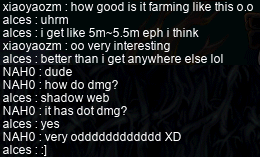
Someone even showed me a comment on Discord™ from an anonymous user who must have seen me solo grinding:

This anonymous commenter appears to be mistaken or confused on two counts. Nevertheless, they are basically right to compare the use of Shadow Web in this way with the use of Poison Mist, although this comes with a boatload of caveats, most of which I discussed in the previous diary entry. Suffice it to say that Shadow Web is vastly less efficient than Poison Mist training, in addition to being considerably more difficult to pull off effectively. The two misconceptions that they seem(?) to have are:
-
That I’m an NL (nightlord); I’m not, I’m just a hermit.
-
That my use of a GDK as my weapon, and my Shadow Web training, are somehow part of a scheme to (ab)use Shadow Web mechanics to make hermits/nightlords more “powerful” in a “mainstream” way than they would have been prior to the innovation of Shadow Web training (or, prior to Shadow Web being fixed & thus becoming usable).
Obviously, I’m reading into it quite a bit here, as I don’t have a lot of context — nor a lot of text — to work with. Nevertheless, it should be emphasised that my use of a GDK as my weapon is directly related to my odd job (viz. daggermit), and thus only indirectly to my class (viz. hermit). Players like myself — and, at least historically, a few others; I didn’t invent the job, nor was I the first to play it — who play ditsin/daggermit/daggerlord are doing so because of its interesting & fun properties, rather than any abstract desire to be more “powerful” in a “mainstream” way.
In particular, Shadow Web training is something that I innovated (as far as I know) because of how difficult it is to level up in mid-to-late 3rd-job levels when your primary or sole source of damage output is Double Stab. I do not actually get particularly good EPH this way: as I said above, it’s probably around 5M〜5.5M if I’m doing fairly well, and that’s at level 110〜119. This kind of EPH, at my level, with my class (hermit), can pretty easily be outdone, I think. One easy improvement is to do SW training with a claw, thus enabling the use of Avenger (and even Shadow Partner to quell WACC issues) for last-hitting, which is clearly superior to Double Stab. Furthermore, as a non-odd hermit, you can just train with HS as a duo or trio in conventional training spots like CDs, Jr. Newties, Gallos, etc., with good partners. Or, you know, last-hit for an actual F/P mage… Furthermore, solo 5–6 F SW training is pretty abysmal for MPM (meso⧸min); it’s not completely awful insofar as I don’t get hit super-duper often, but it’s definitely a pure loss (MPM < 0). Even just going to KMs or whatever is way better.
Anywho, I’ve been sweatin’ it up, so there goes level 114…!:

…And level 115~!:

I decided to try something a little different one time, though. Instead of grindin’ it up, I went with STRginner Taima to kill a pair of ’Tanicas…:
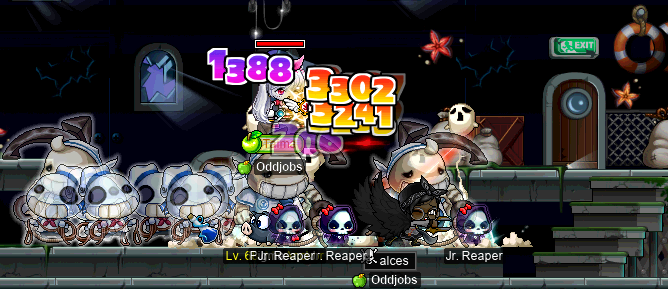
…Which was immediately followed by hunting down & killing as many Headless Horsemen as Boymoder & I could find:

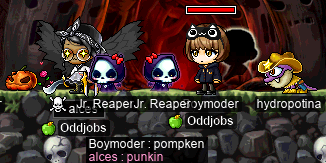
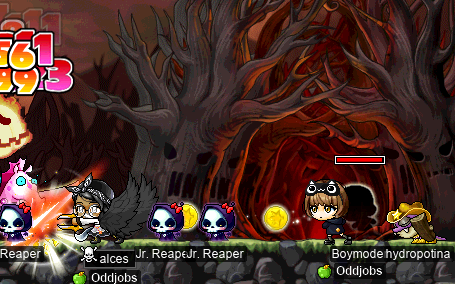
We scoured the Phantom Forest and found three (3) HHs in total. Not too shabby!
Aaaaand back at the 5–6 F sadgrind again, I hit level 116~!:
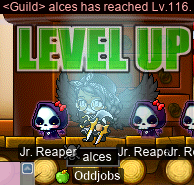
Now that alces is really closing in on the big 120, I have been worrying about what that level entails. In particular:
- Fourth job advancement to the rank of daggerlord, of course.
- The ability to wield the Dragon Khanjar, almighty thief shield of legend.
- Doing the Dragon Elixir quest to enter the Cave of Life and buy an AFK Horntail Necklace (plus Nine Spirit’s Egg) run from some lovely Horntail runners.
Regarding the first item on this list, I have been asked by a few people what exactly is in store for me in 4th job. This is a very reasonable question; using daggers exclusively means that I’m usually locked out of quite a few of my skills that are for claw-wielders only. The way that 1st job works is basically obvious, since it’s not yet specialised in either one of the two weapon types (claw or dagger). In 2nd job, I get:
In 3rd job:
- Flash Jump (“FJ”).
- Shadow Web (“SW”).
- Alchemist (“alch”).
- Meso Up (“MU”).
And finally, in 4th job:
- Shadow Shifter (“shifter”).
- Ninja Ambush (“ambush”).
- Venomous Star (“venom”).
- Taunt.
- Maple Warrior (“MW”).
- Hero’s Will (“will”).
Yeah! 4th job ain’t so bad!! Shadow Shifter will be great to help me stay in place whilst desperately trying to hit things with the incredibly-short-reach Double Stab (plus, I love me some avoidability…). Ninja Ambush is a really interesting one because non-odd NLs typically don’t care much, if at all, about it; there’s no situation for them to use it, but for me it might actually be a cool multi-target attacking skill. And it would be my first real multi-target attack, too; SW is technically not an attack[1], and of course SW cannot affect boss monsters.
It might seem weird that Venomous Star works with a dagger equipped, considering that “Star” is right there in the name. Nevertheless, venom skills (including not just Venomous Star, but also Venomous Stab) can be triggered by just about anything that is an attack, making them useful even for brigands. Also of note is that the venom damage does not take mastery into account, making its damage just as powerful for a daggerlord as it is for non-odd 4th-job thieves.
Taunt is, of course, fantastic for getting some extra EXP. And MW is no slouch either, although I seriously doubt that I will ever have enough SP to actually invest into it myself. Nevertheless, its boost to my LUK is extremely powerful.
That brings me to the second level 120 thingy: the Dragon Khanjar! I did a little bit of owling, and found an already-scrolled one for a pretty good price. Plus, I couldn’t resist buying this one, thanks to its fortuitous item tag:
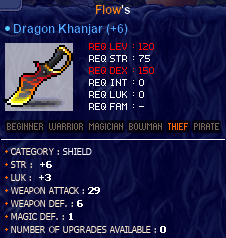
That’s right! This shield is brought to you by the Flow guild, founding member of the Suboptimal alliance!! 😎
And finally, the HTP. I will have to buy AFK for this one, as I am mighty squishy… In any case, I will have to wait until I actually have the egg’d HTP on alces before I can really work out my stats. Equipping thief gear — especially when equipping daggers & shields — is quite the game of “gear Tetris” thanks to the various interdependent stat requirements!
With quite a few days of the alces challenge under my belt, I think that I consider the experiment a “success”, whatever that might mean. I expect it to take me all the way to level 120, and I might try it again with another character in the future. That being said, in my experimentation, I have noticed a few quirks…
Because I am limiting myself to exactly 60 minutes per day, that means that I can do no more than 60 minutes in a given day. As a result, I feel pressured to make as much use of those 60 minutes as possible, knowing that I want to make progress at a swift pace. So I tend to force myself to sadsweatgrind 5–6 F as much as possible, trying to eke out every possible experience point from those 60 minutes. This is perhaps an unfortunate knock-on effect in comparison to just playing “casually” without a particular challenge in mind: without the challenge, I might be more inclined to diversify the things that I do (doing more grinding with friends, bossing, questing, card-hunting even…), and not care so much about each & every EPM.
Furthermore, by making the time constraints totally rigid, I become much more keenly aware of how much I can “get done” in an hour. Then, as my level increases, each further level demands a larger absolute quantity of EXP, and so a single percentage point of EXP becomes larger in absolute terms. It is psychologically difficult to see the percentage points of EXP per hour (%⧸h) dwindle with increasing level, and I admit to doing perhaps a little bit of “fudging” here & there, just so that I can feel better about how many %s I got that day… >.<
Footnotes for “Oh alces, ¡cómo quisiera que te alces al nivel 120!”
-
[↑] It might seem weird to refer to an active skill that deals damage as “technically not an attack”. Nevertheless, SW lacks the game-mechanical properties that typically define an active attacking skill:
- SW can be used with absolutely no weapon equipped, despite not being designed for use with knucklers, and despite not being usable by pirates — indeed, the skill predates pirates entirely, coming from a version of the game in which using an attacking skill without a weapon was merely impossible.
- SW does not cause its user to go into “alert” stance when it is used. Immediately after successfully using SW, the SW user may equip/unequip items, drop items from their inventory, use the FM button, change channels, etc.
- Although SW does target enemies directly, successfully afflicted targets do not take damage upon being afflicted. Only the SW effect (debuff, if you will) causes damage, and the first damage instance may occur only after some time following the initial affliction.
- SW is completely incapable of slaying monsters. If you’ve never played an F/P mage before, then you might naïvely expect this to be true of Poison Mist as well, but it is not: Poison Mist has “attack” and “mastery” values in its skill description because it immediately deals poison damage to any single enemy that is sufficiently close to the caster when the spell is first cast. This initial damage is just ordinary magic damage; it scales with the caster’s TMA (& INT, etc.) as you’d expect, and is capable of lowering its victim’s HP to ≤0.
These properties actually make SW somewhat reminiscent of Heal, which satisfies the first property above, and also satisfies the other properties any time that the caster is not using a weapon. That is, Heal is only an attacking skill when its caster is wielding a weapon — otherwise, it only does what it says in the name: heal the caster & the caster’s nearby allies.
(…cnvpstdf…)
cnvpstdf

![]()

